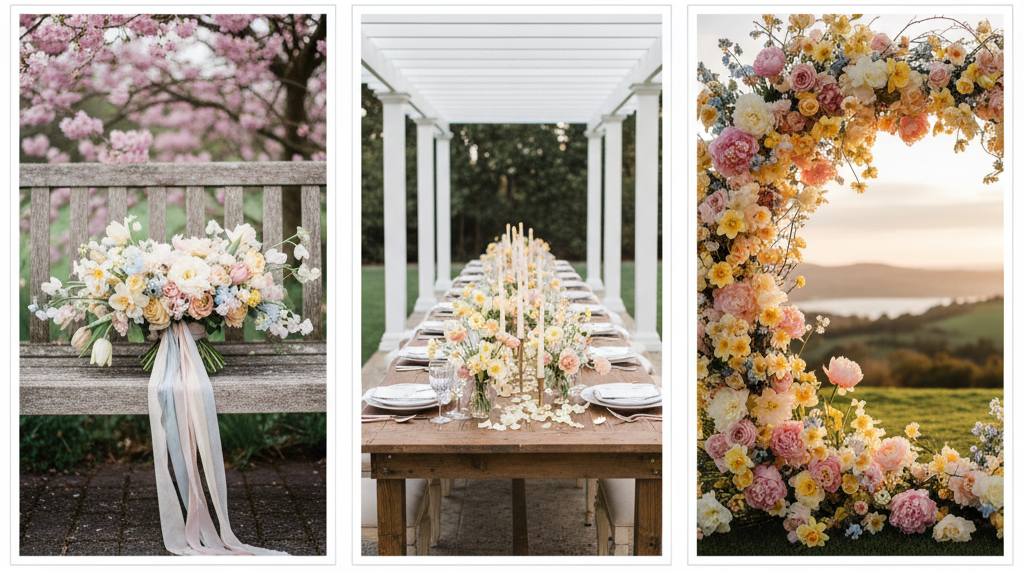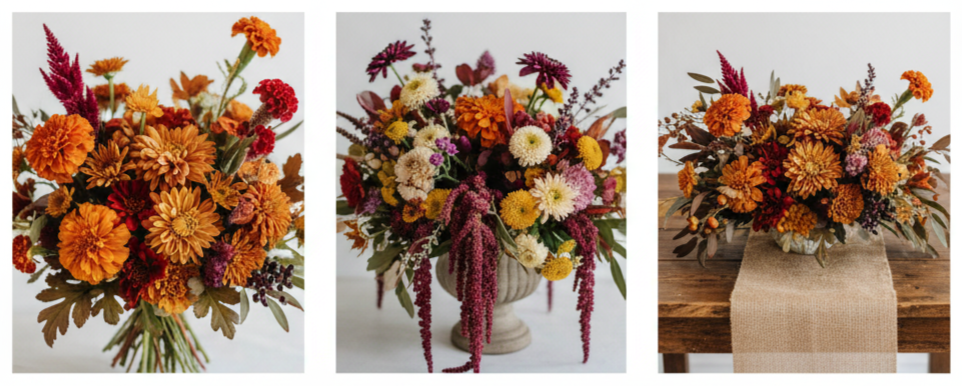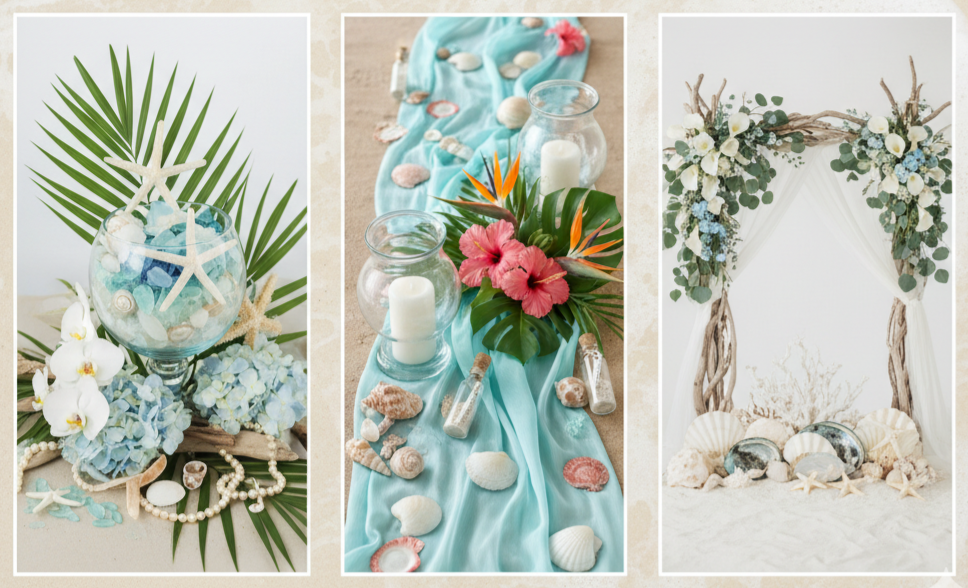Monthly Archives: October 2025
Beach Wedding Hairstyle
| Hairstyle Type | Best Wedding Theme |
| Elegant Chignon | Formal, Traditional |
| Loose Waves | Beach, Garden |
| Braided Crown | Boho, Outdoor |
| Hollywood Waves | Glam, Ballroom |
| Messy Updo | Rustic, Casual |
| Fishtail Braid | Bohemian, Nature-Inspired |
| Slicked-Back Ponytail | Modern, City |
| Half-Up Half-Down | Romantic, All-Around |
Things to Think About Before Picking a Style
Before locking in a hairstyle for your beach wedding, it’s smart to think about a few details that could affect how your hair looks and holds up throughout the day.
- Weather conditions: Between the salty air, ocean breeze, and humid conditions, you’ll need a style that works with—not against—the elements. Think frizz, wind-blown strands, and droopy curls.
- Dress and theme match: Your hairstyle should match your dress and overall wedding vibe. A relaxed braid might go well with a boho lace gown, while a sleek low bun fits a more formal satin dress.
- Hair type: Wavy or curly hair tends to hold up better near the water. Straight hair can still work with some prep and the right texturizing products.
- Accessories to consider: If you’re going with a veil, choose one that’s lightweight and easy to secure. If not, go for a statement hairpiece like a seashell clip or floral crown that won’t blow away mid-vows.
Loose Beach Waves That Never Go Out of Style
Loose waves are the go-to beach bride look effortless, elegant, and wind-friendly. They suit most hair types, especially medium to long lengths, and the breeze just makes them look even better.
To pull this off, you’ll want to start with a texturizing spray to give your hair grip and volume. Whether you’re wearing a strapless dress or something with delicate straps, loose waves pair beautifully and add that extra soft touch to your wedding look.
Messy Buns That Handle the Wind Like a Pro
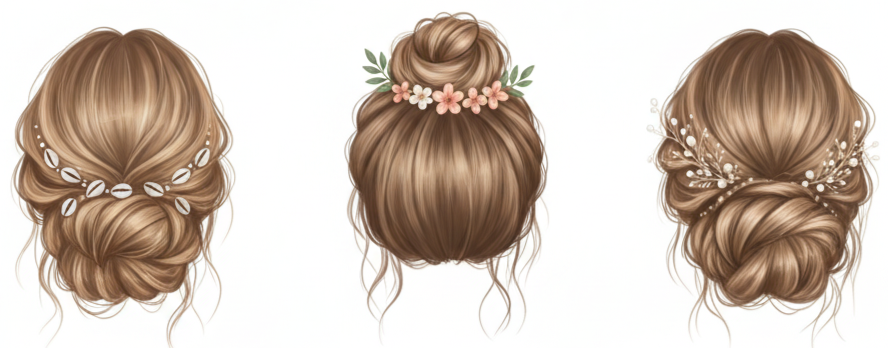
If you’re worried about hair flying all over the place during your beach ceremony, a messy bun might be your best friend. It keeps everything neatly in place while still looking laid-back and romantic.
- Bun placement: You can go with a low bun or a top knot both work well with hairpins, combs, or even a mini flower arrangement tucked in.
- Comfort: Messy buns are great for warmer climates since they keep your neck cool and free.
- Maintenance: They’re super easy to refresh with a few extra pins or a spritz of spray during the day.
Braids That Stay Gorgeous From Sunrise to Sunset
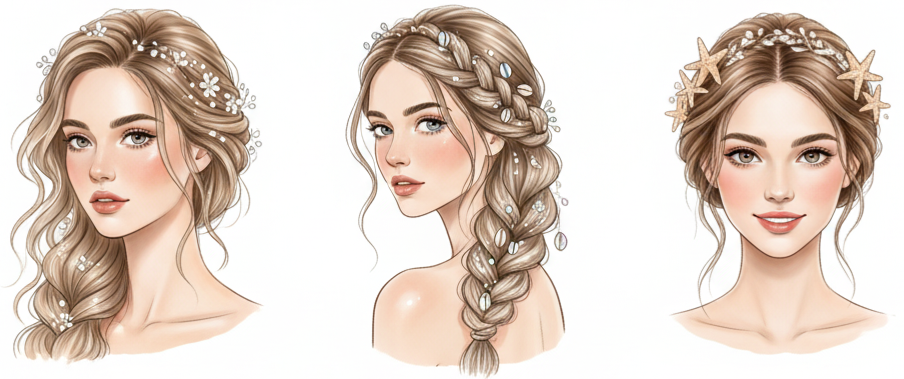
Braids are a popular choice for beach weddings because they hold up really well and add a fun, textured look.
- Style options: You can go for a side braid, fishtail, or a braided crown. All of these offer structure and movement.
- Functionality: Braids keep your hair out of your face and stay intact despite wind and humidity.
- Accessory potential: Braids are a great base for adding accessories like seashell pins or tiny flowers.
Half-Up, Half-Down Styles for the Best of Both Worlds
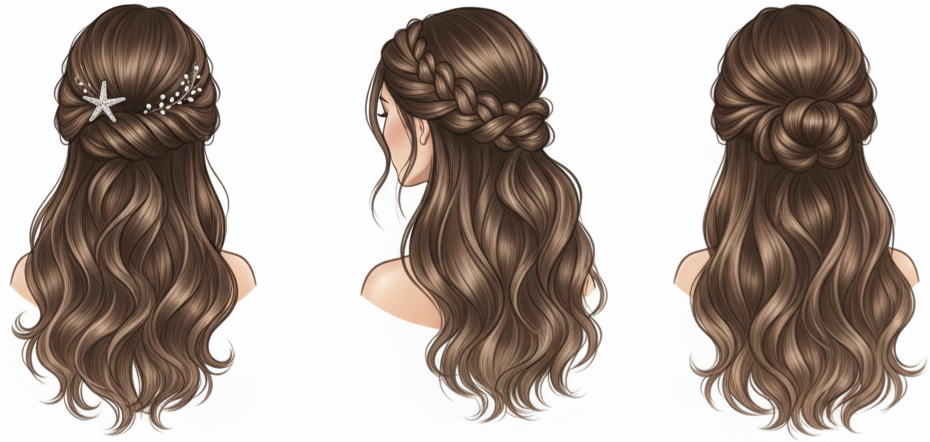
Torn between an updo and letting your hair down? Go half-up, half-down for the perfect mix.
- Versatility: You get the polished feel of an updo with the softness of hair flowing down your back.
- Style details: Curl the bottom layers for extra glam, and style the top half with a braid, twist, or a decorative clip.
- Practicality: This style helps keep hair out of your face while letting you enjoy the natural look of loose strands.
Boho Ponytails That Bring the Chill Vibe

Boho ponytails are perfect for beach weddings because they’re simple, stylish, and low-maintenance.
- Custom look: You can keep it sleek or mess it up with waves and volume.
- Add-ons: A wrap-around strand, ribbon, or floral tie brings in your wedding theme.
- All-day wear: This style holds up well from ceremony to reception without constant touch-ups.
Accessories That Complement the Beach Look
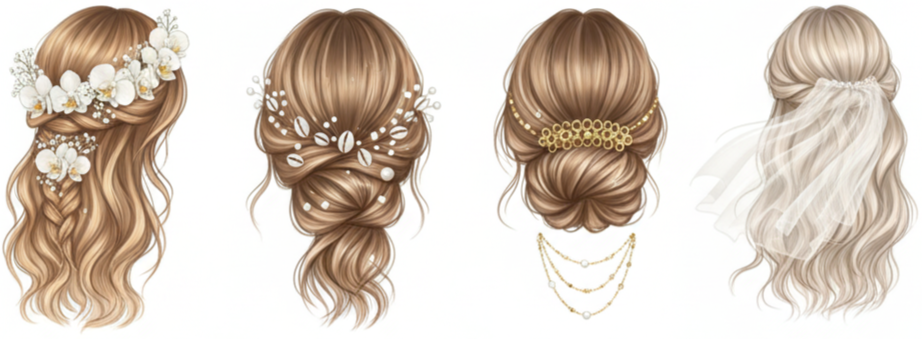
The right accessories can take your hairstyle from pretty to unforgettable.
- Floral clips and crowns: Use hardy blooms like orchids or baby’s breath that won’t wilt easily in the sun.
- Seashell and pearl pins: These add coastal charm while helping to manage flyaways.
- Hair chains and combs: Lightweight and easy to secure, they sit nicely on buns or half-up styles.
- Short veils: If you choose to wear a veil, go for a short, fingertip-length style that can be secured tightly against ocean breezes.
How to Make Your Hair Last All Day at the Beach
Beach weddings are beautiful, but your hair has to battle wind, heat, and humidity. The trick is using the right prep and products.
- Prep your hair: Start with day-old hair instead of freshly washed. It gives better grip and hold.
- Use lightweight products: Go easy on heavy oils or creams. Sea salt spray or volumizing mousse works well.
- Lock the style: Finish with a flexible, anti-frizz hairspray that won’t create crunch but keeps the hair in place.
- Keep a touch-up kit: Bring pins, a mini comb, and styling spray. Have a friend hold onto it for quick fixes.
- Do a trial run: Schedule a trial in similar weather so you and your stylist can make sure the style holds up under the same conditions.
Should You DIY or Hire a Pro for Your Beach Hair?
Getting a professional hairstylist for your beach wedding is often the safest bet—especially if you want a polished, complex look.
- Why hire a pro: An experienced stylist knows how to prep your hair for outdoor settings and use the right products to make the style last.
- When to DIY: If you’re planning a more relaxed look like beach waves or a ponytail, you might feel confident doing it yourself or getting help from a friend.
- Middle ground option: You can also hire a stylist just for the ceremony prep, then handle any needed touch-ups yourself later on.
Conclusion
A beach wedding hairstyle should reflect your personality, hold up against nature’s elements, and fit seamlessly with your dress and theme. You don’t have to overcomplicate it—sometimes the best style is the one that lets you feel relaxed and radiant. Whether you go with soft waves, a structured bun, or a playful braid, the key is prepping the right way and choosing accessories that elevate your look while adding stability.
Key Takeaway: Choose a beach wedding hairstyle that matches your vibe, suits your hair type, and stays put from the first photo to the last dance.
FAQs
What’s the best way to control frizz at a beach wedding?
Humidity-resistant sprays, texturizers, and avoiding heavy products can help control frizz. Using a touch of mousse and flexible hold spray will also lock the style in place.
Can I wear extensions for my beach wedding?
Yes, but go with clip-ins or semi-permanent options that stay secure. Match the texture to your natural hair and secure them well against wind or sweat.
Is it better to style hair at the venue or before arrival?
Styling at the venue is best. It allows for last-minute adjustments based on weather and avoids any styling mishaps caused during travel.
Should I avoid straight hairstyles at the beach?
Straight styles are tricky. Humidity can flatten or frizz them quickly. If you love straight hair, use anti-humidity products and be ready with backup pins and spray.
Can I change my hairstyle between ceremony and reception?
Yes, many brides switch looks after the ceremony. Just make sure you bring the tools and accessories needed to make the transition quick and easy.
Wedding Hairstyles
| Dress Neckline | Best-Suited Hairstyles |
| Strapless / Sweetheart | Loose waves, half-up half-down |
| V-Neck | Low bun, side-swept curls |
| High Neck / Halter | Sleek bun, chignon |
| Off-the-Shoulder | Braided crown, soft curls |
| One-Shoulder | Side bun, side ponytail |
| Boat Neck | Classic updo, French twist |
How To Choose the Right Wedding Hairstyle
Choosing your wedding hairstyle is all about finding something that not only looks beautiful but also feels right. It should go well with your dress, match the theme of your wedding, and stay in place throughout the day.
- Dress neckline: Updos pair best with high-neck or detailed dresses, while loose styles work well with strapless or off-shoulder gowns.
- Hair texture: Fine hair needs volume, so curled styles or buns with teasing are a great match. Thick or curly hair is perfect for braids, twists, or structured buns.
- Venue setting: If you’re having an outdoor wedding, keep wind or humidity in mind and go with a secure style.
- All-day comfort: Go with a look that stays secure but doesn’t feel too tight or heavy during hours of movement and dancing.
Classic Wedding Hairstyles for Timeless Elegance

Some hairstyles never go out of style, and they’re popular for a reason. These looks are elegant, easy to wear, and perfect for both formal and semi-formal ceremonies.
- Chignon: A low, knotted bun that sits at the base of your neck. It’s sleek and polished, and works well with veils, pins, or floral accessories.
- French twist: This style rolls the hair upward and secures it vertically against the head. It’s ideal for black-tie weddings and adds instant sophistication.
- Sleek low bun: Pulled-back with either a center or side part, this bun looks modern yet classic. It suits clean, minimalist bridal looks and structured gowns.
Romantic and Boho-Inspired Bridal Styles

If you’re aiming for a soft and laid-back look, romantic and boho styles are the way to go. These hairstyles blend elegance with natural beauty.
- Loose waves: These soft curls frame your face and add movement. They’re great for outdoor weddings or a relaxed vibe.
- Half-up half-down: This style lets you enjoy the flow of your hair while keeping it out of your face. Add some twists or braids on top for texture.
- Braided crowns and fishtails: These styles bring out a rustic, whimsical charm. They look amazing in garden or beach settings and hold well with hairpins.
Wedding Hairstyles for Short Hair
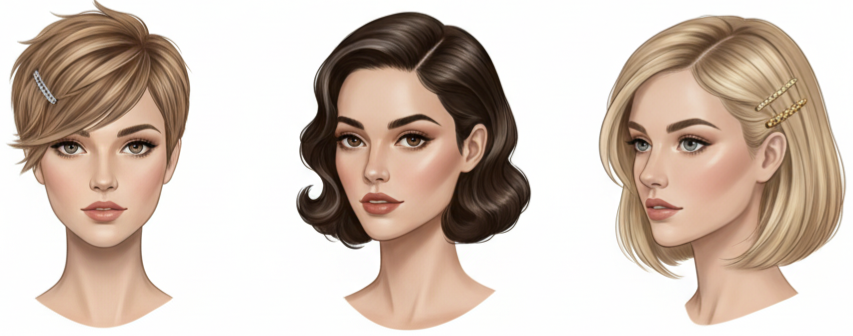
Short hair doesn’t mean limited options. There are plenty of ways to dress up a cropped cut and make it wedding-ready.
- Textured pixie cut: Add volume with styling products and create soft waves or spikes. A side-swept fringe or shiny clip can dress it up even more.
- Curled bob: Curl the ends inward or outward, or go full retro with finger waves. This style gives a vintage or glam twist to a simple bob.
- Pinned-back layers: Use a few statement pins or barrettes to tuck one side of your hair back. It’s easy and classy for jaw-length hair.
Stunning Hairstyles for Long Hair Brides
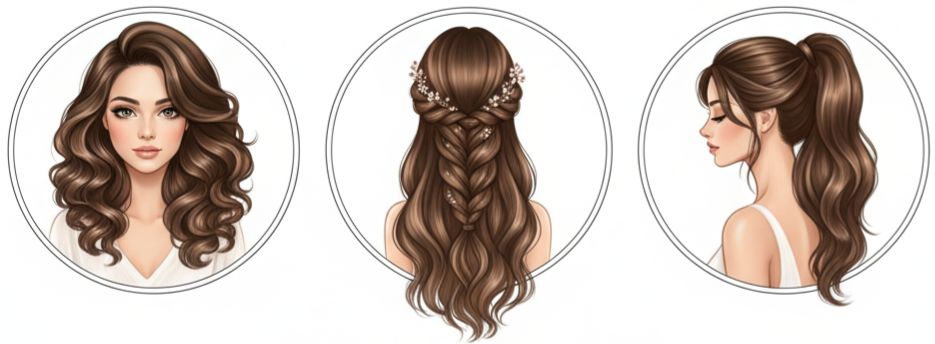
Long hair gives you the freedom to choose from many show-stopping styles. From curls to ponytails, you’ve got options that can match any vibe.
- Voluminous curls: Big, soft curls give your hair body and shape. Use setting spray to keep them looking fresh all day long.
- Waterfall braids: These braids weave through loose hair to create a cascading effect. They’re romantic and work well with boho or whimsical themes.
- Ponytail styles: High or low, wrapped or teased, a ponytail can be elegant when styled with waves or shine. It’s great for modern bridal looks.
Wedding Hairstyles for Curly and Natural Hair

Natural and curly textures bring unique beauty and personality to your wedding look. The key is to choose styles that highlight your hair’s shape and volume.
- Defined natural curls: Enhance your curl pattern with curl creams or gels. Shape your curls to frame your face for a radiant, full look.
- Bantu knots or twists: These traditional styles look artistic and polished. They’re long-lasting and meaningful for many brides.
- Pinned textured updo: Create volume by pinning curls in sections at the crown or back. This style is elegant while protecting your natural texture.
Accessorizing Your Wedding Hairstyle

Accessories can totally shift your hairstyle’s vibe. The right one adds sparkle, softness, or a bold touch.
- Veils: From cathedral to fingertip lengths, the style and placement of your veil should complement your hairstyle’s structure.
- Tiaras and crowns: These pieces add height and sparkle. They’re ideal for bun styles or hair pulled back off the face.
- Floral combs and pins: Add natural charm with fresh or faux flowers. Match the colors to your bouquet for a cohesive look.
- Pearls and crystals: Subtle sparkle works well with minimalist or classic styles. Use them in clips, barrettes, or headbands.
Tips for a Flawless Wedding Hair Experience
To make sure your wedding hair is picture-perfect and stress-free, a little prep goes a long way.
- Book a trial: Schedule a hair trial about one or two months before the wedding. Bring reference photos, your veil, and accessories.
- Talk to your stylist: Share your ideas and concerns, and make sure they understand how your hair behaves in different weather.
- Pack an emergency kit: Include bobby pins, hairspray, a comb, and anti-frizz serum. These little tools can save your day.
- Avoid last-minute changes: Don’t get a new haircut or try a new color right before the wedding. Always give yourself a buffer to adjust.
Popular Wedding Hairstyle Trends
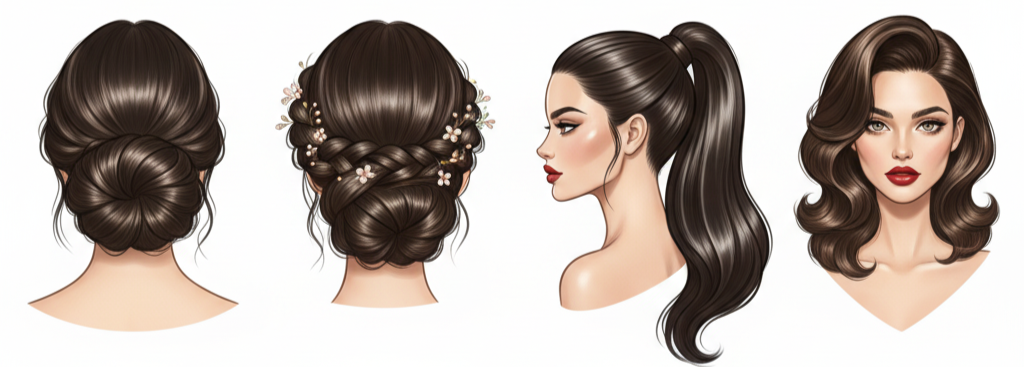
Wedding hair trends change each year, and some of the newest styles are perfect for brides who want to look modern and fresh.
- Textured low buns: These are relaxed versions of the classic bun, with volume and softness around the face.
- Statement braids: Large braids, either standalone or wrapped into updos, are bold and perfect for creative brides.
- Slick ponytails: Sleek roots and curled ends give a runway-ready look while still feeling bridal.
- Retro waves: Vintage-inspired finger waves are glamorous and timeless, especially when paired with bold makeup or a classic gown.
Conclusion
Your wedding hairstyle should make you feel like the best version of yourself. Whether you go sleek, curly, boho, or bold, the right style brings your entire bridal look together. It’s not just about fashion—it’s about feeling comfortable, beautiful, and ready to celebrate.
Key takeaway: The best wedding hairstyles reflect your personal style, match your dress and venue, and stay secure all day without sacrificing comfort.
FAQs
How do I know if I need hair extensions for my wedding hairstyle?
Extensions are helpful when your hairstyle needs extra length or fullness. They’re especially useful for braids, big curls, or voluminous updos.
Can I switch hairstyles between the ceremony and reception?
Yes, many brides do a quick style change. Just be sure to plan ahead and either learn how to do it yourself or book your stylist for a second look.
What’s the best way to handle frizz on my wedding day?
Use anti-frizz serum and humidity-resistant hairspray. A light mist throughout the day can help keep things smooth and shiny.
How long should my wedding hair trial take?
Most trials take one to two hours. That gives enough time to test styles, adjust accessories, and make sure you love the final look.
Do I need to bring my veil and accessories to the trial?
Yes, always bring everything you plan to wear. It helps your stylist design a hairstyle that works well with your entire outfit.
Wedding Hairstyles 2
| Veil Type | Best Hairstyle | Notes |
| Cathedral | Low bun, chignon, French twist | Offers stable base for length |
| Fingertip | Half-up, soft curls, bun | Works above or below the veil |
| Birdcage | Bob, finger waves, side part | Pairs well with vintage styles |
| Elbow-length | Updo, braided crown, curls | Balanced and versatile |
| No veil | Any style | Focus on accessories or texture |
Trending Wedding Hairstyles for 2025 Brides

This year’s wedding hairstyle trends bring a mix of easy elegance and bold personality. One of the most popular looks is the textured ponytail, which combines polished roots with loose, voluminous waves. It’s classy yet relaxed, perfect for modern brides. Sculpted waves are also making a big comeback, inspired by old Hollywood glam with a soft, romantic twist. They look amazing with off-the-shoulder dresses or minimalist gowns.
For those who love daring styles, the wet-look hairstyle is trending. It’s sleek, glossy, and fashion-forward—ideal for brides who want a contemporary edge to their look.
Key takeaway: 2025 hairstyles focus on texture, softness, and individuality, letting brides express their style with effortless beauty.
Timeless Updos That Never Go Out of Style

Updos are a classic bridal go-to—elegant and practical. They highlight your neckline and accessories while keeping your hair in place. A low chignon at the nape of the neck is a timeless pick that flatters any face shape and works with both modern and traditional dresses.
If you’re going for European-inspired elegance, a French twist gives a refined and structured finish. On the other hand, a soft bun with a few strands framing the face adds a touch of romance while keeping the look neat and balanced.
Effortless Down Styles for a Romantic Look

Wearing your hair down gives off a relaxed yet romantic feel. Loose curls are a favorite among brides who want movement and bounce throughout the day. When paired with a light shine mist, the result is natural, radiant, and full of life.
Beach waves continue to be a hit for outdoor and destination weddings. They’re easy to style and look great with floral crowns or subtle clips. If you prefer a minimalist approach, sleek and straight hair with a middle part delivers a polished, modern vibe that pairs well with simple gowns.
Half-Up, Half-Down Hairstyles
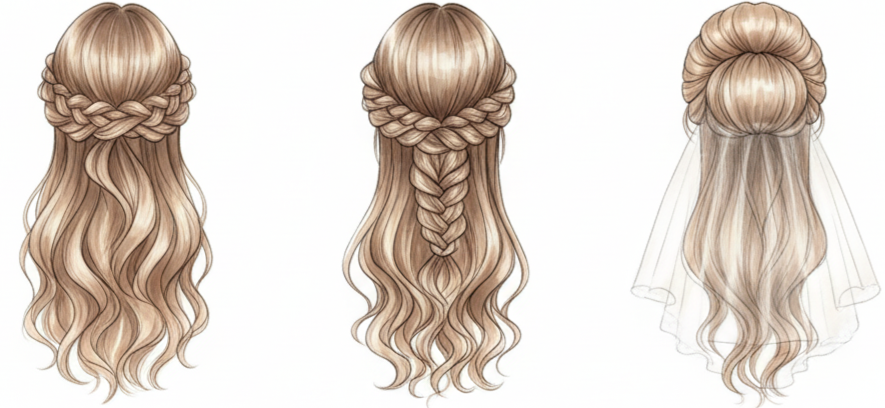
Half-up styles are perfect for brides who want structure without losing softness. A twisted crown style offers natural volume and shape while keeping the face open. It gives that dreamy, fairy-tale look many brides love. For something more detailed, a braided half-up style adds texture and visual interest, especially in photos.
Those who like a little drama might prefer a volumized top section that nods to vintage glamour. It’s elegant yet playful and looks great with or without a veil.
Braided Wedding Hairstyles
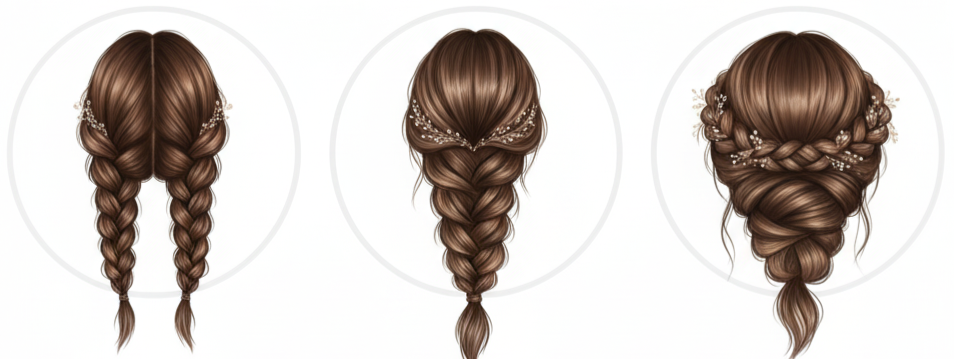
Braids bring character and charm to any wedding look. They add texture, dimension, and a creative edge while keeping the hair secure throughout the day. Dutch braids are bold and structured, ideal for those who love definition and balance. You can wear them as double braids or merge them into a bun for a modern twist.
Fishtail braids are another classic choice. They look intricate and elegant, especially when styled slightly loose for a softer finish. Crown braids, on the other hand, wrap beautifully around the head and create a regal, princess-like look.
Pro tip: Personalize your braid with accessories like ribbons, small flowers, or pearl pins to match your wedding theme.
Short Hair Brides: Chic and Confident Styles

Short hair brings bold bridal vibes. It’s stylish, confident, and full of character. Slick back a pixie for a sleek look or add texture for something fun. Pair it with standout earrings or a bold lip to finish it off.
Classic bobs are simple, stylish, and easy to switch up. Go sleek and straight for a clean look, or add soft waves for something more romantic. Love vintage? Finger waves give off that old-Hollywood feel and look great with minimalist gowns and retro accessories.
Hairstyles That Work With Veils

Your veil plays a big part in your overall look, and choosing the right hairstyle helps it stay secure and stunning. Long cathedral veils look best with structured updos like low buns or chignons, which provide a strong base for the veil to rest on.
If you’re wearing a fingertip-length veil, you can pair it with either an updo or a half-up style. It depends on whether you want the veil to sit above or below your hair volume. For brides going vintage, birdcage veils pair wonderfully with short hairstyles or deep side parts, giving a touch of classic elegance.
Pro tip: Have your stylist attach the veil with a separate comb or pins. That way, you can remove it later without disturbing your hairstyle.
Choosing the Right Hairstyle for Your Dress Neckline

Matching your hairstyle to your dress neckline ensures your look feels balanced and intentional. Strapless dresses pair beautifully with either structured updos that highlight the shoulders or soft curls that frame the neckline.
High-neck gowns look best with lifted hairstyles like buns or twists that keep the neckline clean. For sweetheart and V-neck dresses, half-up styles or cascading curls add symmetry and softness. One-shoulder gowns shine when paired with side buns or deep side parts, creating a harmonious flow between the dress and the hair.
Weather-Proofing Your Wedding Hair

Weather is unpredictable, but your hairstyle doesn’t have to suffer for it. Preparing in advance ensures your look stays flawless all day.
- For summer weddings: Use humidity-resistant products like lightweight mousse and anti-frizz sprays to maintain volume and shape.
- For winter weddings: Hydrate your hair before the big day with deep-conditioning treatments. Finish with heat-protective sprays to prevent static and dryness.
- For rainy days: Opt for strong-hold hairspray and styles like braids or buns that stay secure.
- For windy conditions: Choose updos or pinned-back styles, and attach veils closer to the crown for stability.
No matter the season, the right prep products make all the difference in keeping your hairstyle intact from ceremony to reception.
Final Tips for Your Wedding Day Hair Trial
Your hair trial is your chance to perfect the look before the big day. It helps you and your stylist figure out what works best for your dress, face shape, and overall theme.
Steps for a Successful Hair Trial
- Book early: Schedule your trial about four to six weeks before your wedding. By this point, you’ll have your dress and accessories ready, making it easier to plan your look.
- Bring inspiration: Collect photos of hairstyles you love and show them to your stylist. Choose realistic options for your hair type and length.
- Match your neckline: Try on a top with a neckline like your wedding dress to see how the hairstyle pairs with your overall look.
- Test longevity: Take photos and videos of your hair throughout the day to see how it holds up over time.
- Speak up: Comfort matters. If the hairstyle feels too tight or heavy, let your stylist know so adjustments can be made.
Key takeaway: Treat your hair trial like a dress rehearsal. The more prepared you are, the smoother things will go on your wedding day.
Conclusion
Your wedding hairstyle should feel like an extension of who you are. Whether you love timeless updos, flowing waves, or bold short styles, the best choice is the one that reflects your personality and complements your dress. With thoughtful planning, a trusted stylist, and the right prep, you’ll walk down the aisle with confidence and grace.
Key takeaway: A perfect wedding hairstyle highlights your beauty, matches your gown, and stays flawless from your first photo to your final dance.
FAQs
How long before the wedding should I wash my hair?
It’s best to wash your hair the night before your wedding. Slightly unwashed hair holds curls and pins better than freshly cleaned strands.
Can I use hair extensions for my bridal hairstyle?
Yes, you can! Hair extensions add volume, length, and dimension. Just make sure to test them during your trial so your stylist can blend them seamlessly.
Which hairstyles work best with flower crowns?
Loose curls, half-up styles, and soft braids pair perfectly with flower crowns. They anchor the crown and give it a natural, effortless flow.
Should I change my hairstyle between ceremony and reception?
You can! Some brides prefer a formal style for the ceremony and a relaxed look for the reception. Plan ahead so the transition is quick and easy.
Are there hairstyles that work well for older brides?
Definitely. Soft updos, sleek bobs, and gentle waves look timeless and elegant while keeping the focus on natural beauty.
Wedding Food And Drink
| Catering Style | Description | Best For | Pros | Cons |
| Plated Dinner | Guests served pre-selected meals at the table | Formal weddings | Elegant, consistent portions | Limited variety, higher cost |
| Buffet | Guests serve themselves from a selection of dishes | Casual or large weddings | Variety, flexible portions | Can create lines, less formal |
| Food Stations | Interactive chef-prepared dishes at stations | Modern, social events | Engaging, visually appealing | Requires more space and staff |
| Family-Style | Shared platters passed around each table | Intimate gatherings | Warm, communal atmosphere | Requires larger tables, more food |
Choosing the Right Catering Style for Your Wedding
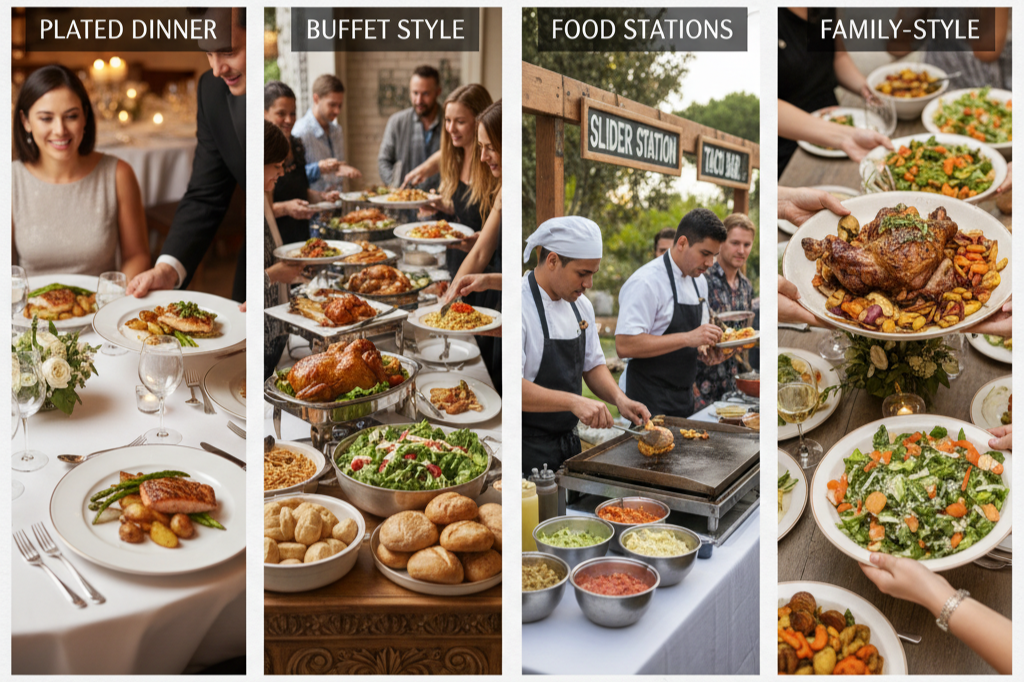
When it comes to feeding your guests, the style you choose sets the entire tone for your wedding. A formal plated meal creates a very different atmosphere than a casual buffet or an interactive food station setup.
- Plated dinner: This is a classic choice where each guest is served the same meal (or a pre-selected option) at their table. It offers a polished and elegant feel, with uniform presentation and portion control.
- Buffet style: With a buffet, guests serve themselves and can choose from several options. It’s less formal but allows for greater variety and flexibility, especially for dietary needs.
- Food stations: These setups feature chefs preparing dishes to order—like tacos, pastas, or sliders. It’s fun, visual, and encourages guests to move around and socialize.
- Family-style: Here, large platters of food are placed on each table for guests to share. It creates a warm, communal atmosphere without the lines of a buffet.
Key takeaway: Pick the catering style that fits your venue, budget, and overall wedding vibe.
Trending Wedding Menu Ideas Guests Will Remember

Today’s wedding menus go far beyond the standard chicken or beef plates. Couples are customizing meals to showcase flavor, culture, and creativity.
- Seasonal menus: Using in-season ingredients makes dishes more flavorful and fresh. Think berries and grilled corn in summer or root vegetables and cozy flavors in fall.
- Global cuisine: Couples are embracing diverse flavors from all over the world—like Indian curries, Thai noodles, or Middle Eastern spreads—to reflect their heritage or shared travels.
- Fusion meals: Dishes like sushi burritos or Korean tacos blend multiple culinary traditions, surprising and delighting guests with bold tastes.
- Plant-based options: Vegan and vegetarian meals are growing in popularity, and caterers are crafting satisfying, flavorful options for every guest.
- Allergy-friendly choices: Make sure your menu includes gluten-free, dairy-free, and nut-free selections so that no guest is left out.
- Late-night snacks: Sliders, fries, or mini donuts make a perfect comeback snack once the dancing begins.
Signature Drinks and Beverage Planning Made Easy

A great wedding drink menu adds to the celebration and helps your guests have a good time—whether they drink alcohol or not.
- Signature cocktails: Design a custom drink (or two) based on your favorite flavors or a shared memory. Give it a fun name for added personality.
- Bar options: An open bar covers all drinks and is most generous. A limited bar includes beer, wine, and a few spirits, which balances experience and budget. A cash bar has guests pay for their drinks, which some couples choose for budget reasons.
- Non-alcoholic drinks: Be sure to offer options like mocktails, soda, lemonade, and flavored waters so non-drinking guests feel included.
- Drink quantities: Estimate about one drink per person per hour. Your bartender or caterer can help fine-tune the numbers based on the guest count and drink preferences.
Key takeaway: Thoughtful drink planning adds character to your wedding and ensures every guest can enjoy something special.
Dessert Ideas That Go Beyond Traditional Wedding Cake

Wedding desserts are becoming more creative, offering couples a chance to have some fun and surprise their guests.
- Dessert bars: Set up a station with customizable treats—s’mores, sundaes, crepes, or even build-your-own cookie sandwiches.
- Mini sweets: Items like cake pops, cupcakes, and tartlets give guests a chance to sample several desserts instead of committing to one big slice.
- Cultural desserts: Share traditional family or cultural favorites, like cannoli, baklava, mochi, or tres leches cake.
- Late-night sweets: Milk and cookies, warm donuts, or handheld pies are perfect for those late-night cravings.
- Cake alternatives: Stack wheels of cheese, build a donut tower, or create a brownie layer “cake” if traditional cake isn’t your thing.
Scheduling a Tasting and Finalizing the Wedding Menu
Tastings are more than just a fun date night—they’re essential to making sure your food looks, tastes, and feels right for the big day.
- When to schedule: Aim for a tasting about 3 to 6 months before your wedding. That gives enough time to make changes and finalize decisions.
- What to focus on: Pay attention to flavor, presentation, and portion size. Make sure each course flows well into the next.
- Questions to ask: Can you swap out ingredients? Can the chef accommodate allergies? What’s the plan if a certain item becomes unavailable?
Key takeaway: Use the tasting to refine your menu and confirm that your caterer understands your vision.
Food and Drink Presentation and Decor Tips

Food should taste great but it should also look amazing. Presentation and styling play a big part in how guests experience the meal.
- Matching your theme: Use props, platters, and serving pieces that fit your wedding’s look—whether that’s rustic, modern, vintage, or tropical.
- Drinkware details: Add charm with personalized napkins, glassware, or creative signage. Handwritten cocktail signs or monogrammed stir sticks add a nice touch.
- Buffet styling: Arrange dishes in an organized and attractive way. Use labeled cards to explain each dish and flag any allergens.
- Lighting accents: Use candles, spotlights, or string lights to make your food stations and bars stand out. It also makes for great photos.
How to Accommodate Dietary Restrictions and Allergies
Making sure everyone has something safe and satisfying to eat shows care and consideration for your guests.
- Collect preferences early: Add checkboxes on your RSVP cards or wedding website for gluten-free, vegetarian, vegan, or other dietary needs.
- Plan with your caterer: Work together to create delicious alternatives that don’t feel like an afterthought. Ask about their allergy protocols.
- Label clearly: Whether it’s a buffet or a plated meal, dishes should be clearly marked to help guests make safe choices.
- Prevent cross-contact: Your caterer should prepare special meals separately and train staff on avoiding ingredient mix-ups.
Key takeaway: Being inclusive with your menu ensures all guests can enjoy your celebration without stress.
Working With Venues and Coordinating Wedding Vendors
Great food doesn’t happen in a vacuum—it depends on good coordination between your caterer, venue, and other vendors.
- Check venue rules: Some venues only allow in-house catering. Others allow outside caterers but may require advance approval, insurance, or permits.
- Understand vendor needs: If the site doesn’t have a kitchen, your caterer may need a prep area, equipment, or access to power and water.
- Confirm paperwork: Make sure your vendors carry the necessary licenses and insurance. Many venues require proof before confirming services.
- Coordinate logistics: Your planner or coordinator should sync with the caterer on arrival times, service windows, table setup, and cleanup details.
Key takeaway: Keeping everyone in sync helps your food service run smoothly from start to finish.
Conclusion
The food and drinks at your wedding are more than just a meal—they’re part of the story you’re telling. With the right style, menu, and attention to detail, your guests will walk away with full stomachs and great memories. Whether you’re serving five-star entrees or late-night tacos, what matters most is that it reflects who you are as a couple and creates a warm, joyful experience for everyone there.
Key takeaway: A thoughtful food and drink plan blends flavor, presentation, and personality to make your wedding truly unforgettable.
FAQs
What’s a good timeline for finalizing our drink menu?
Aim to have your drink menu locked in at least two months before your wedding. This allows time for ordering ingredients and customizing drink names or displays.
How do we handle food waste from the wedding?
Coordinate with your caterer about leftovers. Some offer takeaway boxes, while others can help you donate extra food to a local shelter or food bank.
Is it okay to use a food truck instead of a traditional caterer?
Yes, food trucks can be a fun, casual alternative—especially for outdoor weddings. Just confirm space and power requirements with your venue.
Can we include our own family recipes in the menu?
Definitely. Many caterers love working with family recipes and can adapt them for large groups. Just share the recipe early for testing.
Do we need a separate vendor for our cake and dessert table?
Not necessarily. Some full-service caterers offer both savory and sweet items. However, if you want a custom cake or specific desserts, a specialty bakery might be a better fit.
Wedding Food
| Catering Style | Vibe | Pros | Cons |
| Plated Dinner | Formal | Elegant, organized service | Limited variety, higher cost |
| Buffet | Casual/Flexible | Variety, guest control | Long lines, less polished look |
| Family Style | Warm/Social | Interactive, communal feel | Needs space, more servers |
| Food Stations | Trendy/Custom | Entertaining, personalized | Requires space, complex setup |
| Cocktail-Style | Modern/Mingling | Easy movement, stylish bites | May not fill guests completely |
Understanding Your Wedding Style and How It Shapes Your Menu

Your wedding style says a lot about what kind of food experience you should create. Whether you’re planning something elegant or laid-back, your menu should match the overall theme.
- Venue Atmosphere: A ballroom wedding usually calls for a plated dinner with refined service, while an outdoor or rustic venue fits perfectly with BBQs or buffets.
- Seasonal Relevance: For summer, think light and fresh—like seafood and salads. For winter, go for hearty dishes and warm drinks.
- Guest Count: Smaller weddings allow for more personalized and gourmet dishes, while larger receptions benefit from practical options that keep service smooth.
- Cultural Traditions: Including your background through food—like Italian pasta or Indian curry—adds a personal touch that makes your celebration unique.
Matching your food with your wedding style ensures everything feels cohesive and memorable.
How to Pick the Best Catering Style for Your Wedding

Choosing the right catering setup determines how smoothly the meal flows. Different styles work for different vibes, budgets, and venues.
- Plated Dinner: A sit-down meal feels formal and elegant. It’s organized, looks beautiful, and serves everyone at once. However, it limits variety and may raise service costs.
- Buffet Style: Guests love the flexibility of picking their favorites. It’s great for mingling, though it can lead to longer lines and more food waste.
- Family Style: This approach feels warm and social, with platters passed around each table. It encourages conversation but requires more space and staff.
- Food Stations: Think of it as interactive dining—guests can visit stations for sushi, pasta, or tacos. It’s exciting, though more complex to coordinate.
- Cocktail-Style Reception: Bite-sized appetizers and drinks replace a formal meal. It’s modern and fun, but not ideal for those expecting a full dinner.
Each style creates a different atmosphere, so go with what fits your personality and budget.
Wedding Menu Ideas That Guests Actually Remember
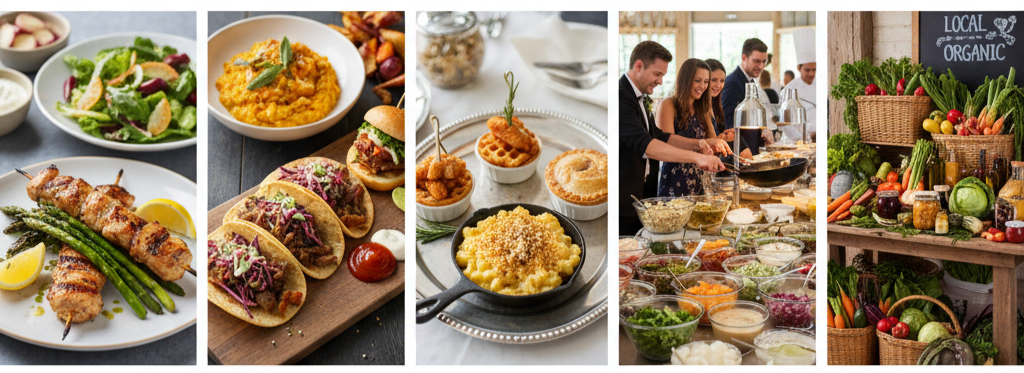
The right food choices turn your wedding into a flavor experience everyone talks about later. Keep things creative yet familiar.
- Seasonal Menus: Use fresh ingredients from local farms. Summer weddings might include grilled veggies and citrus-based dishes, while fall weddings could feature pumpkin risotto or roasted meats.
- Fusion Cuisine: Combine flavors from different cultures, like Korean tacos or Mediterranean-style sliders.
- Upscaled Comfort Food: Serve familiar favorites with a fancy twist—mini chicken and waffles, truffle mac and cheese, or bite-sized pot pies.
- Interactive Bars: Guests love customizing their meals at pasta or poke bowl stations.
- Farm-to-Table Options: Highlight fresh, organic, and local produce for a sustainable touch.
A mix of creativity and balance makes your menu unforgettable.
All About Wedding Desserts and Sweet Displays

Desserts are more than just a sugar rush—they’re a big part of the visual appeal. Couples today are mixing tradition with modern creativity.
- Dessert Bars: Offer a mix of mini treats like mousse cups, cookies, or cake pops for guests to sample freely.
- Cupcake Towers: A playful and elegant choice that allows for multiple flavors and easy serving.
- Donut Walls: Perfect for photo ops and late-night snacks.
- Candy Stations: Colorful glass jars filled with your favorite candies add a fun nostalgic vibe.
- Themed Desserts: Create personalized sweets like monogrammed cookies or macarons that match your wedding colors.
You can still keep the cake-cutting moment alive with a small decorative cake while offering other desserts around it.
What to Know About Wedding Drinks and Bar Options

Drinks complete the wedding food experience, and there are several ways to keep everyone refreshed and entertained.
- Open Bar: Offers guests freedom to order what they want, though it’s the most expensive route.
- Limited Bar: Focus on a few drink choices—beer, wine, and one or two signature cocktails.
- Dry Wedding: Skip alcohol entirely and offer mocktails, flavored sodas, and fancy coffee setups.
- Signature Cocktails: Personalize the bar with drinks that represent your story or favorite flavors.
- Self-Serve Stations: Easy-to-maintain options like lemonade or sangria dispensers work well for outdoor weddings.
Make sure there’s something for everyone—those who drink and those who don’t.
Making Your Food Look as Good as It Tastes

Food presentation can transform your dining setup from basic to breathtaking. Guests eat with their eyes first, so style matters.
- Elegant Plating: For plated dinners, balance colors and textures to create restaurant-quality visuals.
- Creative Buffet Layouts: Use raised platforms, labels, and floral accents to make buffets look stylish.
- Consistent Styling: Keep the look of your stations, linens, and signs aligned with your wedding theme.
- Stylish Tableware: Vintage dishes, gold-rimmed plates, or wooden boards add character.
- Live Cooking Elements: Watching chefs prepare sushi or flambé crepes adds excitement and entertainment.
A beautiful presentation enhances both taste and the overall guest experience.
Late-Night Snacks and Food Truck Fun

As the night winds down, guests appreciate one last bite before heading home. Late-night snacks are a hit at any wedding.
- Savory Snacks: Think sliders, tacos, or mini pizzas—easy to grab and delicious after hours of dancing.
- Sweet Options: Try churros, cookies and milk, or s’mores kits for a cozy feel.
- Food Trucks: Bring the party outdoors with a food truck serving tacos, ice cream, or gourmet sandwiches.
- Local Favorites: Include regional specialties that represent your hometown or cultural roots.
These fun bites keep guests happy until the very end of the celebration.
Working with a Caterer and Getting It Right
Partnering with the right caterer makes all the difference. You want someone who understands your vision and executes it perfectly.
- Tasting Sessions: Always do a tasting to sample flavors and presentation before signing any contract.
- Portfolio Review: Check out their previous work to see if their style matches your theme
- Menu Flexibility: Find a caterer open to customizing dishes for dietary needs or personal preferences.
- Service Inclusions: Confirm if setup, linens, and cleanup are included in the package.
- Venue Familiarity: A caterer who’s worked at your location before will handle logistics more efficiently.
- Backup Plans: Ask about contingency measures for power outages, weather issues, or food delays.
- Permits and Insurance: Make sure the caterer is properly licensed and insured.
- Transparent Pricing: Get a clear cost breakdown to avoid surprises later.
Good communication and planning with your caterer ensure a smooth and delicious dining experience.
Conclusion
Wedding food is more than just the meal—it’s a reflection of your story as a couple. From appetizers to desserts, every bite should feel like part of the celebration. By choosing a menu that fits your theme, hiring the right caterer, and adding thoughtful details, you’ll give guests an experience that’s personal, seamless, and unforgettable.
Key Takeaway: The best wedding food connects people, reflects your personalities, and turns your big day into an experience everyone will savor long after it’s over.
FAQs
What’s the average cost per guest for wedding catering?
Most couples spend between $40 and $100 per person, depending on menu choices and service style. This usually covers appetizers, entrees, and non-alcoholic drinks.
Should we offer menu choices for a plated dinner?
Yes, it’s smart to give guests a few entrée options, including a vegetarian dish. Be sure to collect meal preferences in your RSVPs.
Can we include family recipes in the menu?
Absolutely. Many caterers can adapt family recipes as long as they meet health and safety guidelines.
Is serving only appetizers acceptable for a wedding?
It works well for shorter or early-day weddings. Just let guests know ahead of time so they don’t expect a full meal.
Do we need extra desserts if we already have cake?
Cake is often enough, but offering a few extra sweets like cookies or mini tarts can make dessert time feel more indulgent.
Wedding Flowers
| Season | Flowers |
| Spring | Tulips, Peonies, Sweet Peas, Daffodils |
| Summer | Sunflowers, Dahlias, Garden Roses, Zinnias |
| Fall | Marigolds, Chrysanthemums, Celosia, Amaranthus |
| Winter | Amaryllis, Anemones, White Roses, Pine/Holly |
Choosing the Right Wedding Flowers

Picking wedding flowers goes beyond picking what looks pretty. It’s about setting the mood for your big day and making sure everything flows together beautifully.
- Seasonality: Choose blooms that are in season. They’ll be fresher, more affordable, and easier to find.
- Color Palette: Keep your flower colors in sync with your wedding theme, attire, and venue design.
- Venue Style: A ballroom might call for roses and orchids, while wildflowers work perfectly for a garden or barn wedding.
- Fragrance and Symbolism: Strong scents like lilies can fill a space quickly, while peonies and ranunculus keep things light.
- Budget: Prioritize what matters most—like your bouquet and ceremony flowers—and then plan the extras around your remaining budget.
When everything aligns—colors, theme, and season—your flowers will make your wedding day feel naturally cohesive and elegant.
Popular Wedding Flowers and Their Meanings
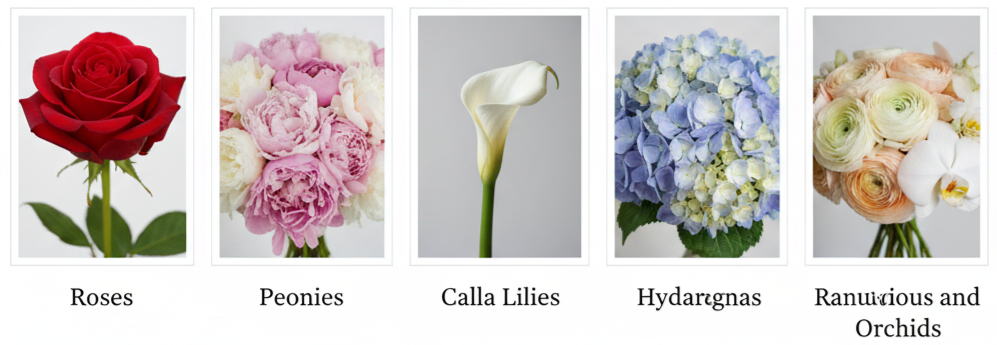
Every flower carries a little bit of meaning, making your wedding feel even more personal. Roses symbolize love and romance, which is why they’re a timeless favorite. Peonies bring luck and happiness, adding fullness and softness to any bouquet.
Calla lilies, with their sleek lines, represent purity and elegance—perfect for a modern wedding. Hydrangeas are known for expressing gratitude and emotion, making them ideal for family-centered ceremonies. Ranunculus adds charm and texture, while orchids embody luxury and strength. Each bloom tells part of your love story in its own beautiful way.
Seasonal Flower Guide
Spring Blooms
Spring is a season full of new beginnings, making it perfect for weddings. You’ll find tulips, daffodils, sweet peas, and peonies in abundance. Their pastel colors and delicate scents bring freshness to any venue.
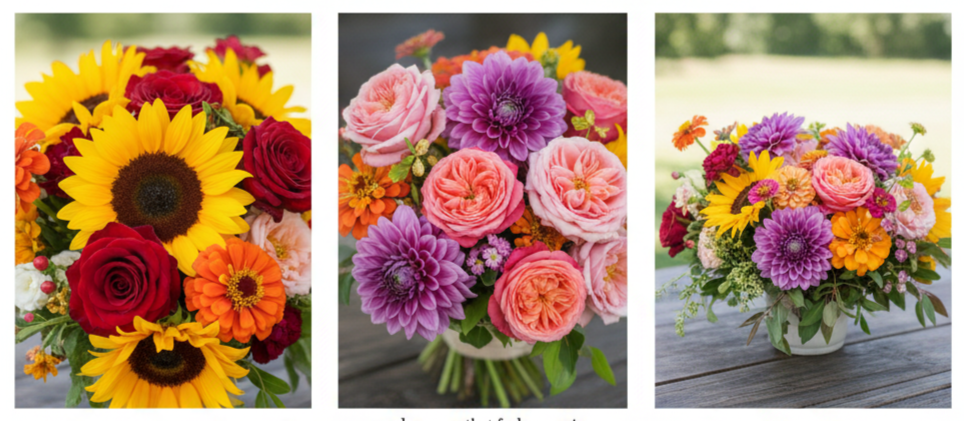
Summer Picks
Summer flowers are bold and colorful. Think sunflowers radiating warmth, garden roses that feel romantic, dahlias for a dramatic touch, and zinnias to add pops of color. They handle heat well and bring energy to outdoor celebrations.
Fall Favorites
Fall weddings shine with rich, earthy tones. Marigolds and chrysanthemums bring warmth, while celosia and amaranthus add texture. These blooms complement rustic and bohemian themes beautifully.
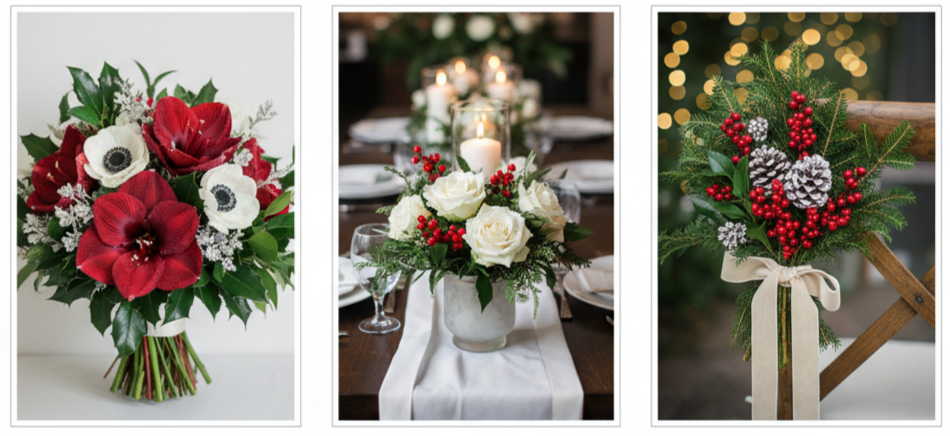
Winter Options
Winter weddings offer a unique charm. Amaryllis and anemones add drama, while white roses and pine accents bring in the season’s crisp elegance. Holly and evergreen touches give your décor a cozy, festive feel.
Wedding Flower Arrangements to Consider

Your flower arrangements are what tie your entire day together. The bridal bouquet is your main floral piece and should reflect your personality and dress style. Bridesmaids’ bouquets often mirror the main bouquet but are smaller and simpler.
For the ceremony, arches and aisle flowers create a breathtaking backdrop. Boutonnieres and corsages add a personal touch for the wedding party and family members. At the reception, table garlands, centerpieces, and floral accents on the cake complete the look.
Every petal plays a part in creating the atmosphere—from walking down the aisle to dancing the night away.
Wedding Flower Trends

Modern weddings are all about creativity and sustainability. Dried and preserved florals are becoming increasingly popular, giving arrangements a rustic, textured look that lasts. Many couples are also opting for eco-friendly designs, like foam-free installations and locally sourced blooms.
Bright and bold colors are replacing the traditional whites and blush tones. Vibrant corals, oranges, and pinks are making big statements. On the other hand, minimalist bouquets featuring just a few standout flowers bring modern elegance. Monochrome designs—using one color in varying shades—are also on trend for a chic, cohesive look.
Key takeaway: Modern wedding flowers reflect individuality and sustainability, blending creativity with eco-conscious choices that feel timeless.
Tips for Working with a Florist
Working with a florist is all about communication and collaboration. Come prepared with ideas, photos, or even fabric swatches to help describe your style.
- Be Clear About Your Budget: Share your price range early so the florist can recommend suitable flowers and designs.
- Ask About Seasonal Options: Go for flowers that are in season for better prices and freshness.
- Do a Test Arrangement: Previewing your bouquet or centerpiece helps ensure you love the final look.
- Plan the Delivery: Confirm details about when and where the flowers will arrive and who’s setting them up.
A professional florist can transform your ideas into reality, ensuring your wedding blooms are as stunning as you imagined.
Budgeting for Wedding Flowers
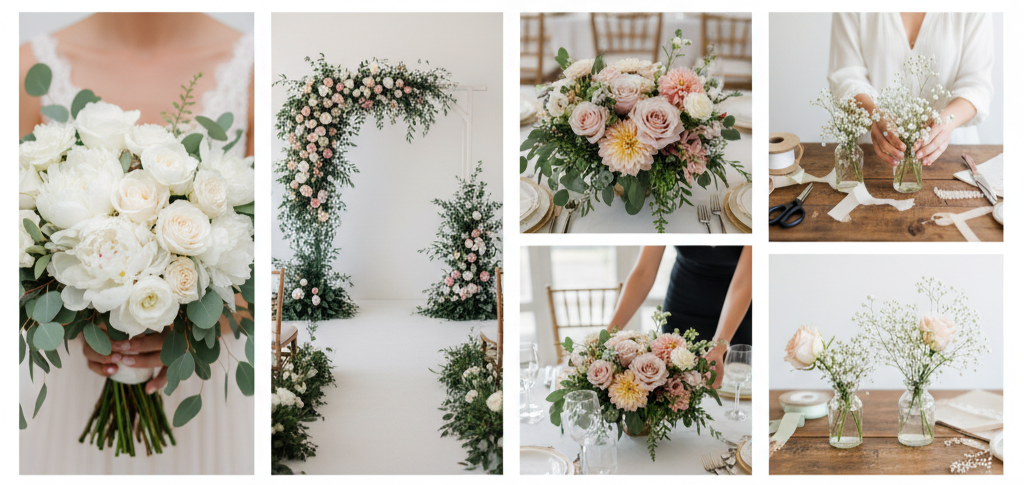
Wedding flowers can take up a good chunk of your budget—usually around 8–10% of the total cost. However, smart planning helps you get the most value without compromising on beauty.
- Focus on Priorities: Spend on key pieces like your bouquet, ceremony backdrop, and reception centerpieces.
- Mix and Match: Combine premium flowers with filler blooms or greenery like eucalyptus to balance costs.
- Repurpose Arrangements: Move flowers from the ceremony to the reception to stretch your budget further.
- DIY Small Pieces: If you enjoy crafting, consider creating simple floral accents yourself, like guest table vases.
With thoughtful planning, you can have show-stopping flowers that fit your budget perfectly.
Floral Styling for Different Wedding Themes

Every wedding theme tells a story, and your flowers bring that story to life. For timeless elegance, roses, peonies, and lilies in soft shades like blush or ivory create a sophisticated atmosphere. Rustic weddings shine with wildflowers, sunflowers, and plenty of greenery in wooden or mason jar containers.
Bohemian weddings favor dried flowers, pampas grass, and unique textures like protea. Modern weddings look sleek with monochrome arrangements of calla lilies or orchids. For beach celebrations, tropical flowers such as hibiscus and anthuriums pair beautifully with natural seashell details. And for a garden party vibe, loose, airy blooms like roses, lavender, and sweet peas make everything feel dreamy and romantic.
Preserving Wedding Flowers

Your wedding day may be over, but your flowers can live on. Drying your bouquet is the easiest way to keep it—simply hang it upside down in a dry, dark space for a few weeks. Pressing flowers between heavy books or parchment paper also makes beautiful framed keepsakes.
If you want to retain the color and shape, try using silica gel to dry them. Or, you can go the professional route and have your bouquet preserved in resin, glass, or a shadow box. These lasting mementos are a lovely reminder of one of the most meaningful days of your life.
Conclusion
Wedding flowers do more than decorate the venue—they set the entire tone of your celebration. From the bridal bouquet to the reception table, every petal adds to your story. When you choose flowers that reflect your season, style, and personality, your wedding becomes a true expression of love and creativity.
Key takeaway: The perfect wedding flowers don’t just look good; they make your day feel cohesive, meaningful, and unforgettable.
FAQs
How do we choose flowers that won’t wilt in the heat?
Go for hardy options like orchids, calla lilies, sunflowers, or zinnias. These blooms handle outdoor weddings well without losing their shape.
What are some flower alternatives for allergic guests?
Use hypoallergenic flowers like roses, tulips, or hydrangeas. You can also incorporate more greenery or realistic faux blooms to reduce allergens.
Is it possible to rent wedding flowers?
Yes, many rental companies offer high-quality silk flower options for bouquets, arches, and centerpieces—perfect for saving money or destination weddings.
What should we avoid doing when picking wedding flowers?
Avoid choosing flowers that are out of season if you’re on a budget, and make sure your florist can handle your venue’s delivery and setup logistics.
Can we combine real and artificial flowers?
Definitely. Mixing both types can help you cut costs while still achieving a natural, cohesive look. Just make sure the colors and textures blend seamlessly.
Wedding Drinks
| Season | Drink Ideas | Flavors/Notes |
| Spring | Elderflower spritz, Lavender lemonade | Floral, citrus, light |
| Summer | Frozen margarita, Cucumber cooler | Refreshing, fruity, crisp |
| Fall | Apple cider mimosa, Maple old fashioned | Spiced, warm, earthy |
| Winter | Irish coffee, Cranberry gin fizz | Bold, cozy, rich |
Pre-Ceremony Drinks That Set the Mood
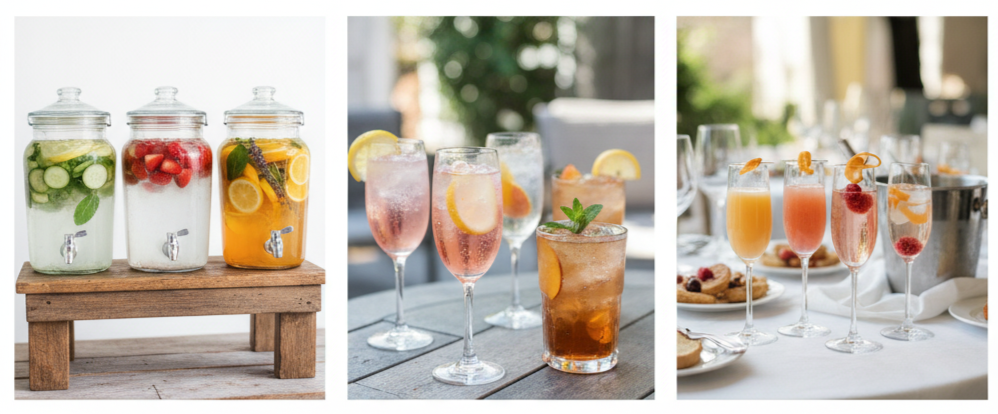
- Infused waters: Greet guests with chilled dispensers filled with fruit-infused water. Flavors like cucumber-mint, lemon-strawberry, or orange-lavender add a refreshing touch.
- Sparkling options: Sparkling lemonade and flavored iced teas are light, colorful, and perfect for outdoor or warm-weather weddings.
- Morning cocktails: For brunch weddings or early ceremonies, offer light drinks like mimosas, bellinis, or prosecco with a twist of fruit.
Offering drinks before the ceremony creates a warm and relaxed atmosphere. It’s also a great way to keep guests comfortable while they wait.
Signature Cocktails That Represent You Both

- Custom creations: Design a drink that reflects each of you. Use favorite spirits, flavors, or themes to craft a bride and groom cocktail.
- Creative names: Give your cocktails names based on inside jokes, locations, or personality traits.
- Seasonal ingredients: Match your ingredients to the season—think berries in summer or cinnamon and apple in fall.
- Color matching: Choose drink colors that match your wedding palette. This keeps everything looking cohesive and photo-ready.
Signature cocktails give guests something fun to remember—and they’re a great way to show off your personalities.
Deciding Between a Full Bar and a Limited Bar
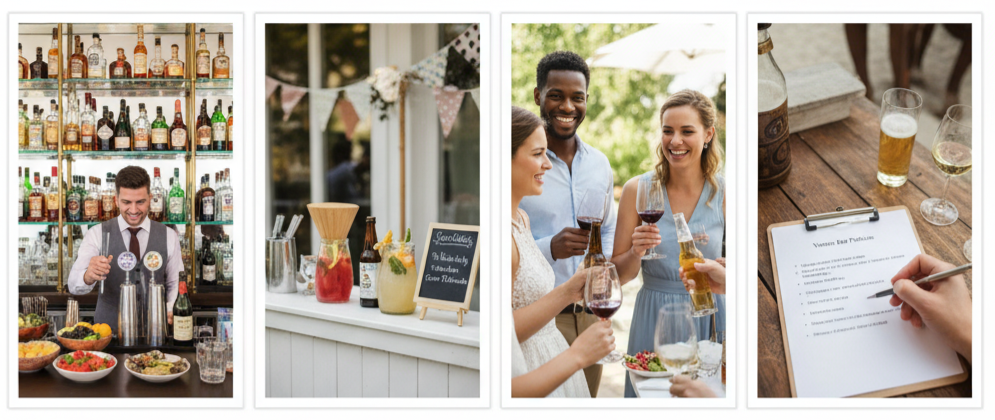
- Full bar: Offers a wide selection of liquor, mixers, beer, and wine. Guests can order nearly anything they want, which adds flexibility but increases cost.
- Limited bar: Focuses on a few curated options—usually beer, wine, and 1–2 signature cocktails. This setup is budget-friendly and keeps things simple.
- Guest preferences: Consider what your guests typically drink. If most people stick to wine and beer, a limited bar might be the perfect choice.
- Venue guidelines: Some venues may have restrictions or preferred vendors, so check ahead before finalizing the drink list.
Balancing drink selection and budget is easier when you think through guest habits and your event size.
Picking the Right Wines and Champagne

- White wines: Sauvignon Blanc, Pinot Grigio, and Chardonnay pair nicely with chicken, fish, and vegetarian meals.
- Red wines: Cabernet Sauvignon, Merlot, and Pinot Noir are ideal for beef, lamb, or pasta dishes.
- Rosé wines: Serve rosé for a versatile, light option that suits spring or summer menus.
- Sparkling wines: Champagne is classic for toasts, but Prosecco and Cava are excellent budget-friendly alternatives.
- Pairing with food: Coordinate wines with your courses to elevate the meal and create a more elegant dining experience.
Wine and champagne choices should reflect your menu and the overall vibe of the wedding, whether that’s casual or upscale.
Non-Alcoholic Drinks That Still Feel Fancy

- Mocktails: Whip up non-alcoholic takes on classics like mojitos, margaritas, or berry spritzers. They’re just as tasty and festive—no alcohol needed.
- Juice and soda bars: Set up a build-your-own station with flavored sodas, juices, and sparkling water for interactive fun.
- Coffee and tea: A specialty station with lattes, herbal teas, syrups, and toppings offers guests something warm and comforting—especially for evening weddings.
- Kid-friendly options: Lemonade, fruit punch, or mini slushies are great for younger guests.
Thoughtful non-alcoholic options make sure everyone feels included, regardless of their age or drinking preferences.
How You Present the Drinks Makes All the Difference
- Drink stations: Use bar carts, rustic tables, or champagne towers to showcase beverages in a stylish way.
- Custom touches: Add personalized drink stirrers, engraved glasses, or bar menus with custom designs that match your theme.
- Garnishes: Use edible flowers, fresh fruit, or herbs to enhance drinks visually and aromatically.
- Signage: Clearly label all drinks with fun, eye-catching signs or menus to help guests make quick choices.
Presentation turns a regular drink into an experience, especially when the details tie into your wedding style.
Keeping It Safe and Smooth Behind the Bar
- Professional bartenders: Hire licensed bartenders who can mix properly, watch for overconsumption, and manage crowd flow.
- Hydration stations: Encourage water intake with citrus- or herb-infused water stations placed near the bar or dance floor.
- Last call: Announce last call about 30 minutes before the end of the event to give guests time to wrap up.
- Transportation options: Provide information about rideshares, local taxis, or shuttle buses to make sure guests get home safely.
Good bar management ensures guests stay safe while still having a great time. It also protects you from liability concerns.
Drink Ideas That Match the Season
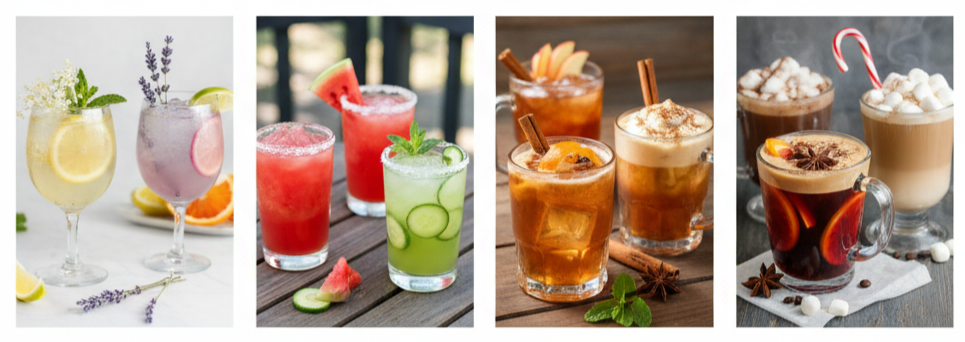
- Spring: Elderflower spritzers, lavender lemonade, and citrus cocktails work well for floral themes and mild temperatures.
- Summer: Frozen cocktails, watermelon margaritas, and cucumber coolers keep things light and refreshing.
- Fall: Apple cider sangrias, maple whiskey sours, and pumpkin spice liqueurs fit the cozy, rustic vibe.
- Winter: Serve warm drinks like spiked hot chocolate, mulled wine, and Irish coffee for cold weather celebrations.
Seasonal drink choices not only taste better but also match the overall tone of your wedding and décor.
Personalizing Your Drink Menu for a Unique Touch
- Local ingredients: Use spirits or wines from local vineyards or distilleries to support regional businesses and add a unique story to each drink.
- Themed drinks: Create cocktails inspired by your travels, favorite movies, or even your pets. Add custom names and cute descriptions.
- Interactive ideas: Let guests vote for their favorite cocktail, or include a DIY garnish bar to make their drinks more fun.
- Recipe cards: Place printed drink recipes at the bar so guests can recreate your cocktails at home.
Personal touches make your drink menu feel intentional and memorable—not just another wedding standard.
Conclusion
Wedding drinks do more than keep people refreshed—they shape the vibe of your entire event. With thoughtful planning, you can create a drink lineup that reflects your personality, matches the season, and works within your budget. Whether you’re serving signature cocktails, non-alcoholic mocktails, or carefully paired wines, every choice contributes to the guest experience. It’s all about balancing fun, flavor, and function while giving your guests something to sip and savor.
Key takeaway: The right drink selection brings people together, adds a personal touch to your big day, and helps create a wedding experience your guests won’t forget.
FAQs
What’s a good ratio for alcohol to guests at a wedding?
A good rule of thumb is to estimate one drink per person per hour. For a five-hour event with 100 guests, plan on around 500 drinks split across beer, wine, and cocktails.
Can we create a custom mocktail for our wedding?
Definitely! A mocktail made with fresh herbs, juice, and sparkling water brings all the flavor and fun—plus, everyone can enjoy it.
Is it okay to skip hard liquor at our wedding?
Yes. Many couples choose to offer just beer and wine or include one signature cocktail to simplify the menu and keep costs down.
Should we offer drinks during the ceremony?
Most couples stick to offering drinks before or after, but for informal or outdoor weddings, pre-ceremony welcome drinks are a great touch.
How do we handle last call without killing the vibe?
Give guests a 30-minute heads-up with a fun announcement. Shift focus to dessert, coffee, or late-night snacks to keep the celebration going.
Wedding Dress
Blog post imported from: https://www.invitesweddings.com/b/wedding-dress
Wedding Decorations
| Theme | Colors | Materials | Signature Decor |
| Classic Elegance | White, Gold | Satin, Crystal | Chandeliers, Full Floral Bouquets |
| Rustic Charm | Earth Tones | Wood, Burlap | Mason Jars, Wooden Signs |
| Bohemian Bliss | Neutrals, Pastels | Macramé, Lace | Pampas Grass, Dreamcatchers |
| Modern Minimalist | Black, White | Acrylic, Metal | Geometric Shapes, Clean Lines |
| Vintage Romance | Soft Pinks, Ivory | Lace, Velvet | Antique Frames, Candelabras |
Choosing a Wedding Theme That Sets the Tone
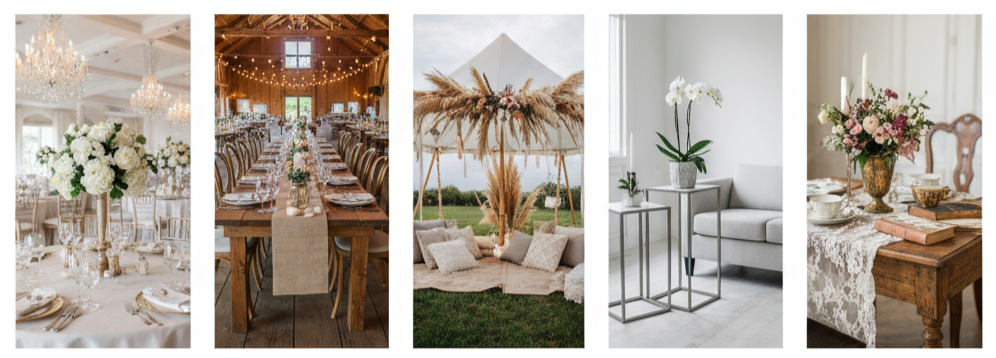
Picking your wedding theme sets the mood for the entire celebration. Once you decide on a theme, every other detail naturally follows.
- Classic Elegance: A timeless style with white, cream, and gold tones, crystal chandeliers, and luxurious floral arrangements.
- Rustic Charm: Perfect for countryside weddings, featuring wood accents, burlap runners, and mason jar centerpieces.
- Bohemian Bliss: Earthy tones, pampas grass, lace fabrics, and soft ambient lighting create a relaxed and whimsical vibe.
- Modern Minimalist: Clean lines, simple color palettes, and geometric accents bring a contemporary look.
- Vintage Romance: Antique furniture, lace overlays, and heirloom touches give a nostalgic, romantic atmosphere.
Key Takeaway: A well-defined theme ties everything together, ensuring your wedding feels cohesive and reflects your personality.
Designing the Ceremony Space
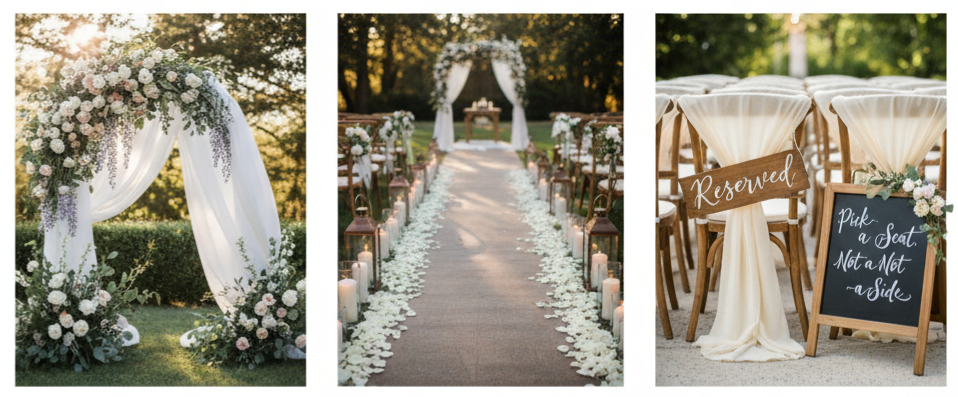
The ceremony is the heart of your day, so its decor should feel meaningful and beautiful.
- Ceremony Backdrops: Floral arches, draped arbors, geometric frames, or rustic wooden doors make perfect focal points.
- Aisle Decorations: Petals, candles, and lanterns lining the aisle create a warm and romantic entrance.
- Seating and Signage: Personalized signs, chair sashes, and reserved labels make the space organized and charming.
For outdoor ceremonies, add thoughtful touches like parasols or fans in summer and cozy blankets in cooler months to keep guests comfortable.
Transforming the Reception Venue
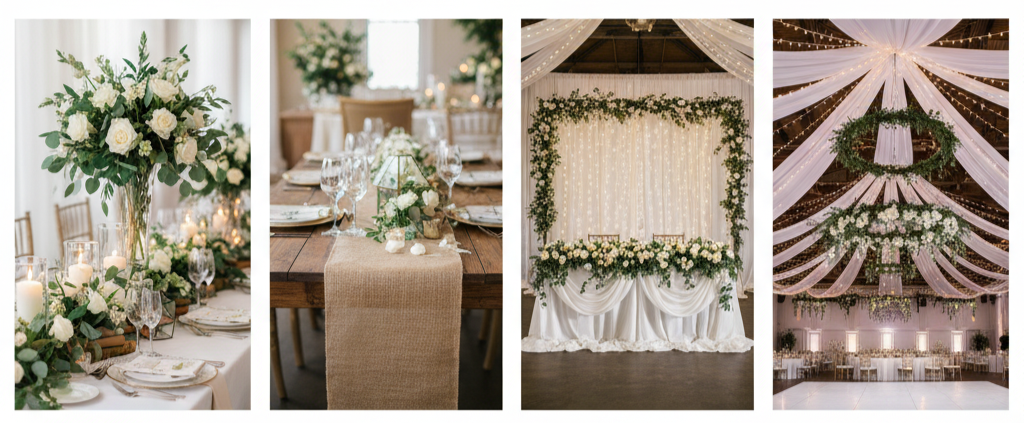
Once guests enter the reception, your decor takes center stage. Tables, lighting, and backdrops all come together to create the perfect party setting.
- Table Centerpieces: Tall floral vases add height, while low arrangements make it easier for guests to chat. Lanterns or candles bring intimacy, and unique objects like books or terrariums add personality.
- Table Linens: Choose fabrics that complement your theme—satin for luxury, burlap for rustic charm, velvet for vintage style, and linen for a minimalist aesthetic.
- Head Table Setup: This is your visual highlight. Enhance it with a custom backdrop, floral garlands, or a light display.
- Ceiling and Wall Decor: Draped fabric, string lights, or floral installations make the space feel elegant and complete.
Every corner should feel purposeful while keeping the flow comfortable for guests to mingle and celebrate.
Floral Arrangements That Make a Statement

Flowers add color, scent, and energy to your wedding decor.
- Bouquets: Choose a style that complements your theme—wildflowers for boho, roses for classic, or bold tropical blooms for a modern twist.
- Boutonnieres and Corsages: Small details that help tie the wedding party’s attire into the overall floral scheme.
- Ceremony Florals: Use blooms to frame the altar, line the aisle, or accent seating areas.
- Reception Florals: Place arrangements on tables, bars, and signage to extend the floral theme throughout the venue.
A great tip is to reuse ceremony flowers during the reception to maximize both your budget and the visual impact.
Lighting That Sets the Mood
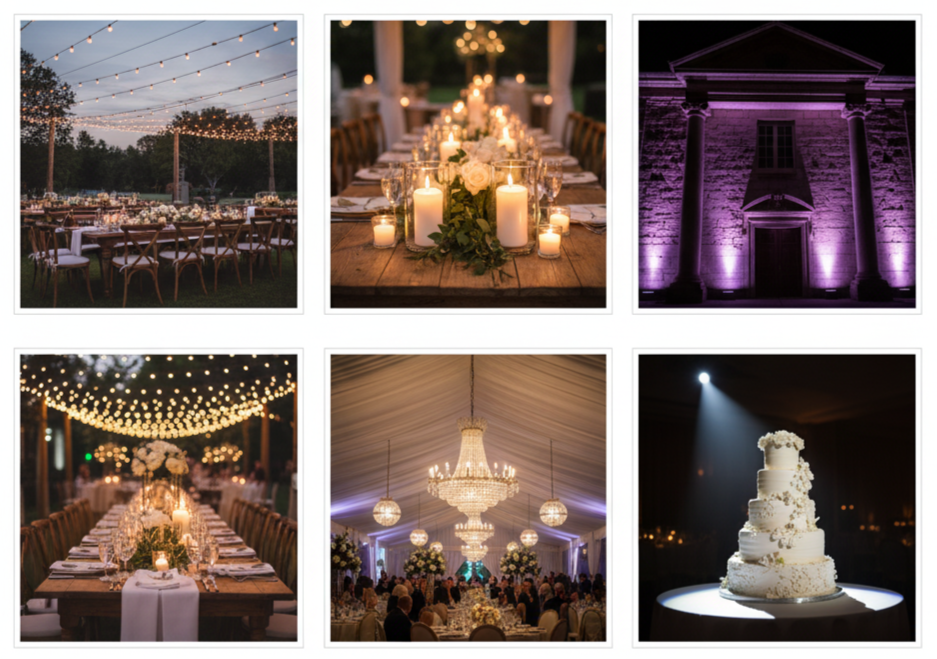
Lighting affects the entire atmosphere and even how your photos turn out.
- String Lights: Ideal for outdoor or rustic celebrations, creating a soft and magical glow.
- Candles: Scatter them on tables or along walkways to set a romantic mood.
- Uplighting: Adds depth and warmth to walls or corners, enhancing the venue’s character.
- Spotlights: Highlight key areas such as the cake table, dance floor, or sweetheart table.
- Chandeliers and Pendants: Perfect for adding luxury to indoor or tented weddings.
Adding creative lighting features like LED dance floors or monogram projections can make your wedding feel truly unique.
DIY Wedding Decorations for a Personal Touch
DIY decorations bring personality and heart to your wedding while helping manage your budget.
- Custom Signage: Hand-painted boards, mirrors, or acrylics for welcome signs, table numbers, or quotes.
- Escort Cards: Mini frames, handwritten tags, or small keepsakes make creative seating guides.
- Wedding Favors: Homemade candles, soaps, or treats make meaningful gifts for guests.
- Photo Displays: Use string lights and clips to hang photos that tell your love story.
- Guest Books: Think outside the box—like fingerprint trees or Polaroid scrapbooks.
Start your DIY projects early to avoid last-minute stress and ensure your designs match your wedding theme.
Decor Trends Dominating 2025 Weddings
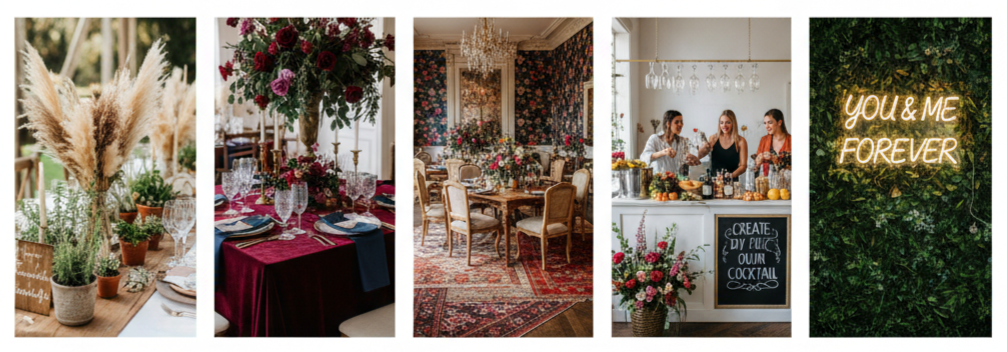
Modern weddings are leaning toward bold, sustainable, and personalized designs.
- Sustainable Decor: Using dried flowers, renting decor, or adding potted plants to reduce waste.
- Moody Color Palettes: Deep greens, navy, and burgundy tones add depth and sophistication.
- Maximalist Designs: Layered textures and bold prints replace minimalism with abundance.
- Interactive Decor: Fun elements like DIY cocktail bars or live guestbook stations keep guests engaged.
- Neon Signs: Custom lights featuring names or favorite quotes add a playful, modern glow.
These trends make weddings more personalized and visually memorable, moving away from traditional setups.
Hiring a Wedding Decorator: When to Bring in the Pros
Sometimes, it’s worth bringing in professionals to make your vision a reality.
- When to Hire: Consider a decorator for large weddings, tight timelines, or complex themes.
- Benefits: They handle logistics, ensure design consistency, and have access to quality materials and suppliers.
- Preparation: Bring inspiration photos or a mood board to communicate your vision clearly.
- What to Ask: Check if they handle setup and cleanup, what’s included in their package, and how flexible they are with your budget.
Working with a decorator saves time and ensures every detail aligns with your desired aesthetic.
Seasonal Wedding Decoration Tips

Decorating according to the season enhances your theme and helps you make the most of natural beauty.
- Spring: Pastel colors, blooming branches, and flowing fabrics give a fresh, romantic feel.
- Summer: Bright hues, tropical greens, and lightweight fabrics suit sunny weather. Include fans or parasols for comfort.
- Fall: Warm oranges, rust tones, and deep reds create a cozy atmosphere. Add texture with velvet napkins or dried florals.
- Winter: Jewel tones, evergreen garlands, and twinkling lights make for a festive setting.
Always choose weather-resistant materials for outdoor weddings and secure lightweight items against wind or rain.
Final Details That Leave Lasting Impressions
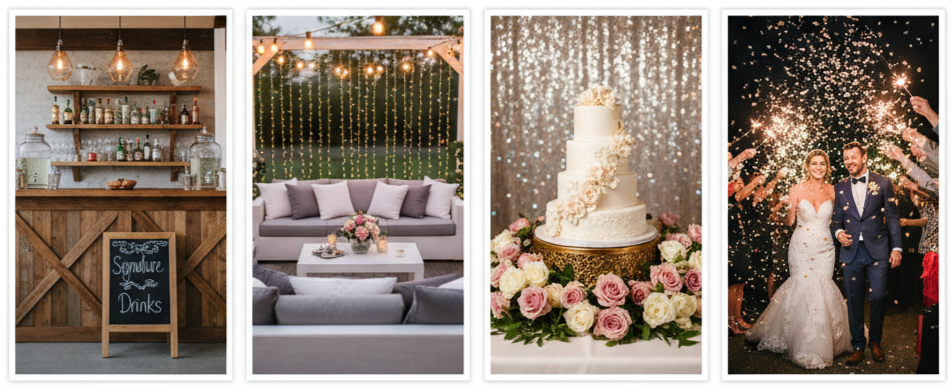
Small touches make your wedding unforgettable.
- Custom Cocktail Bars: Add themed signage or signature drinks for guests to enjoy.
- Lounge Areas: Create cozy spaces with sofas and cushions for guests to relax and chat.
- Cake Displays: Use risers, floral accents, or decorative backdrops to showcase your desserts.
- Send-Offs: Sparklers, confetti, or ribbon wands create magical photo moments as you exit.
These finishing details bring personality and flair, ensuring your wedding feels both polished and personal.
Conclusion
Wedding decorations are what transform your venue into a reflection of your story. Every detail, from the aisle to the reception tables, works together to create an unforgettable experience. Whether you go for a grand setup or something more intimate, the key is making sure it feels like you. Mixing thoughtful touches, the right lighting, and personal accents will give your wedding the magic it deserves.
Key Takeaway: Great wedding decor doesn’t just look beautifulit captures your personality, creates the right mood, and makes your celebration unforgettable.
FAQs
What’s a good timeline for finalizing wedding decor?
Most couples finalize their decor choices about 2–3 months before the big day. This gives plenty of time for ordering, DIY projects, and vendor coordination.
How do I choose between real and faux flowers?
Real flowers give a natural scent and look, while faux ones last longer and work better for extreme temperatures. It depends on your theme, budget, and venue conditions.
Can I mix decor styles in one wedding?
Yes, mixing styles works beautifully when done with consistency. Stick to a unified color palette or repeated texture to make everything feel intentional.
What’s the best way to decorate a small wedding space?
Keep decor minimal but meaningful. Mirrors, hanging lights, and streamlined furniture open up the space without cluttering it.
How can I save money on wedding decorations?
Reuse ceremony flowers for the reception, rent items instead of buying, and focus on statement pieces. DIY elements like signage and favors also help stretch your budget.
Wedding Decoration Ideas
| Season | Flowers | Colors | Materials |
| Spring | Tulips, Peonies | Pastels, Soft Greens | Lace, Light Fabrics |
| Summer | Orchids, Hibiscus | Brights, Coral, Aqua | Linen, Rattan |
| Fall | Mums, Dahlias | Burgundy, Gold, Burnt Orange | Wood, Velvet |
| Winter | Roses, Evergreens | Navy, Silver, Emerald | Velvet, Metallics |
Choosing Your Wedding Theme
Choosing your wedding theme is a fun part of planning—it guides your decor and pulls everything together. Whether you go rustic, modern, or romantic, your theme sets the mood for the whole celebration.
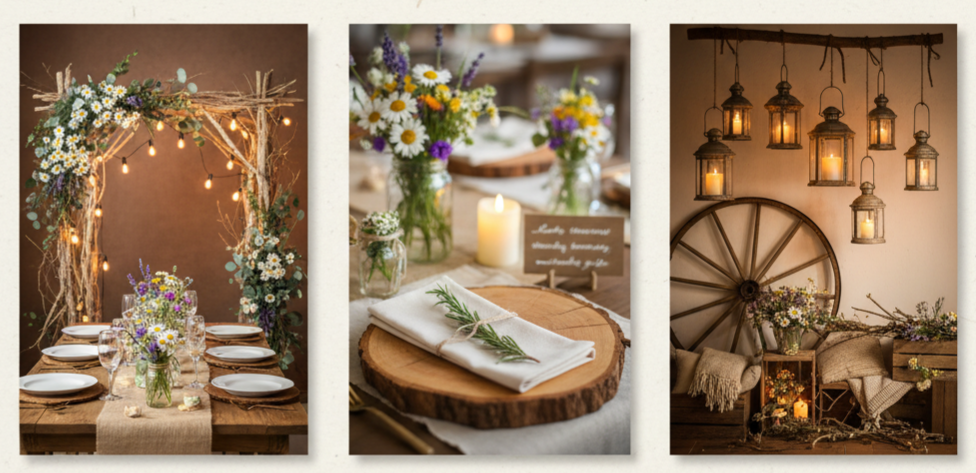
Rustic Theme
Think wooden accents, wildflowers, and soft lighting for a cozy, countryside feel.
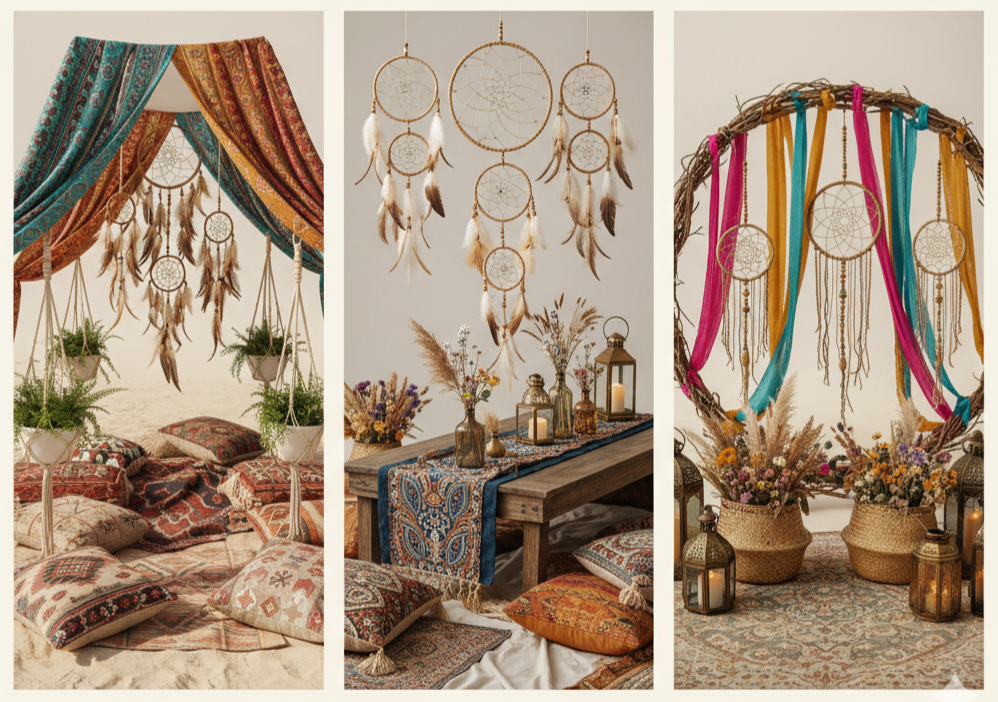
Bohemian Theme
Use colorful fabrics, dreamcatchers, and unique patterns for an eclectic, laid-back atmosphere.
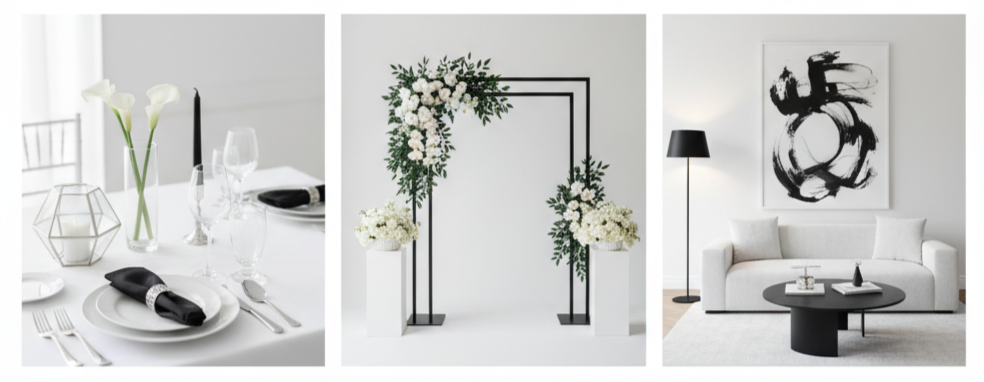
Modern Theme
Go for clean lines, minimalist decor, and monochromatic tones for a sleek, stylish setup.
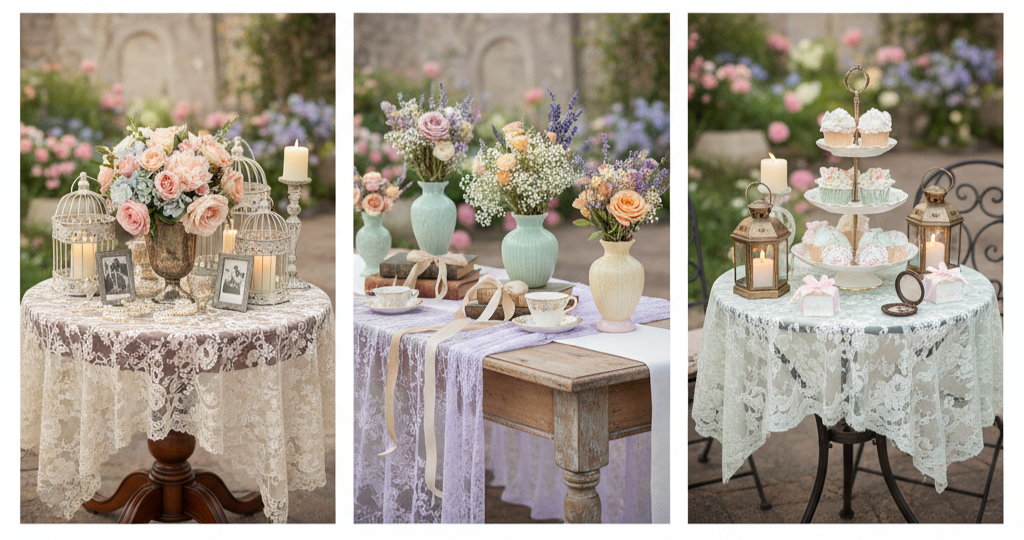
Vintage Theme
Incorporate antique furniture, lace tablecloths, and pastel shades to bring an old-world charm.
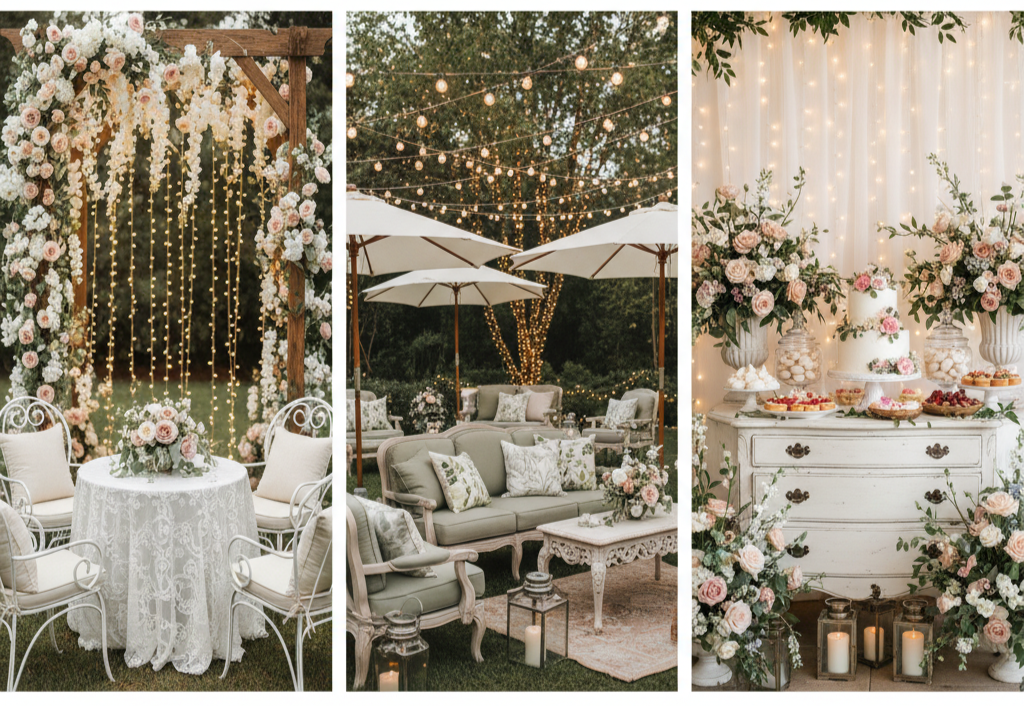
Garden Party Theme
Picture floral garlands, outdoor seating, and soft fairy lights.
Beach Theme
Add seashells, tropical flowers, and ocean-inspired details to complement the setting.
Key point: Match your theme with the venue. A barn fits a rustic vibe, while a ballroom is perfect for something classic or elegant. Keeping your venue and theme aligned makes the entire wedding look seamless.
Ceremony Setup Ideas
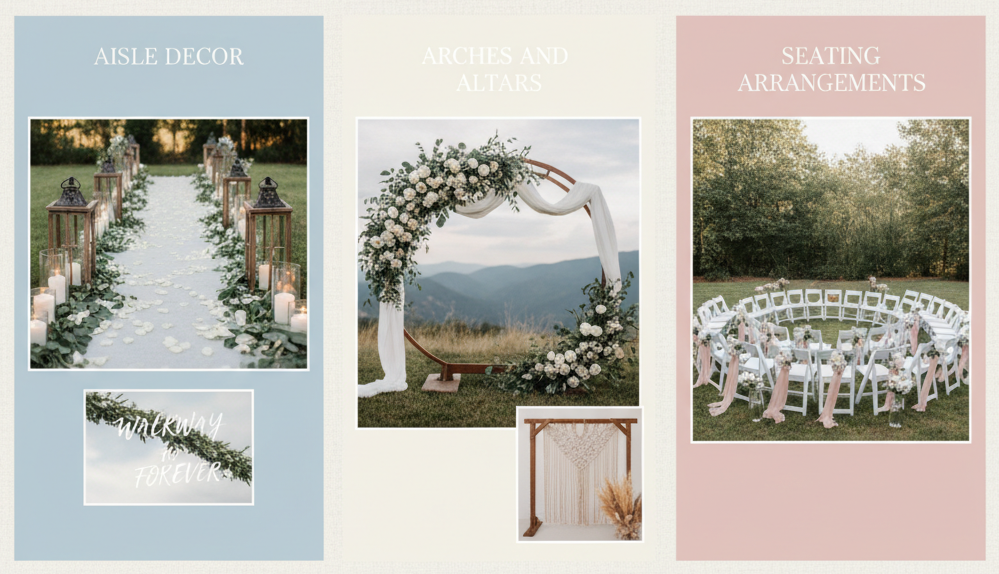
Your ceremony sets the vibe for the whole day, so make sure every detail, from the aisle to the altar, shows off your story and style.
- Aisle Decor: Dress up the walkway with flower petals, lanterns, or greenery. For a modern twist, consider candles in glass holders or mirrored signage.
- Arches and Altars: The ceremony backdrop should make a statement. Floral arches, wooden frames, or draped fabric with greenery create a beautiful focal point.
- Seating Arrangements: Think beyond straight rows. Circular seating brings intimacy and better visibility for guests. Add small floral touches or ribbons to chairs for a polished finish.
The ceremony area is where emotions run high and photos are captured, so every design choice should feel meaningful and authentic.
Reception Venue Decor

The reception is where your theme comes to life. It’s your chance to wow your guests and make lasting memories.
- Table Centerpieces: Use tall floral arrangements for drama or low, lush displays for an intimate feel. Mix textures—like glass, metal, and wood—to keep the look interesting. Adding candles or small lanterns creates a romantic glow.
- Lighting Options: The right lighting changes everything. String lights bring warmth, chandeliers create elegance, and uplighting highlights the room’s best features. Candles add a cozy, inviting touch to any table setting.
- Photo Areas and Backdrops: Create a spot for fun photos with a flower wall, custom neon sign, or colorful backdrop. It not only entertains guests but also adds another decorative element to the venue.
Your reception design should feel comfortable yet elegant, encouraging guests to mingle, dance, and enjoy every moment.
Outdoor vs. Indoor Wedding Decor
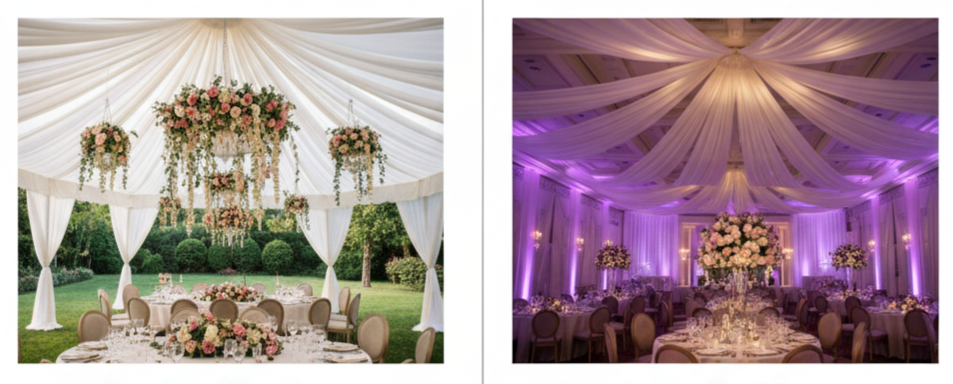
The setup for outdoor and indoor weddings comes with its own opportunities and challenges. Each space requires a little creativity to bring your vision to life.
- Outdoor Weddings: Use nature as your backdrop. Hanging floral chandeliers from trees, tented ceilings with fabric draping, or aisle markers made of wood or flowers all look stunning. Always plan for weather changes—secure decor properly and have a backup tent ready.
- Indoor Weddings: Indoors, you can completely transform the space. Use ceiling drapes to add height and softness. Colored lighting or monogram projections personalize the room. Wall uplighting and floral arrangements can make even a simple hall feel luxurious.
No matter the location, your decor should complement the environment and reflect your personal style.
DIY Wedding Decorations
Adding DIY touches to your wedding makes it personal and memorable. Plus, it can help save money without compromising beauty.
- Simple DIY Ideas: Use mason jars as centerpieces with flowers or candles. Create handmade welcome signs or table runners from fabric or lace.
- Personal Touches: Incorporate photos, mementos, or travel souvenirs that tell your love story. A memory table featuring family pictures or heirlooms adds a heartfelt element.
- When to Hire Help: DIY is perfect for smaller details you can make ahead of time. Leave large installations, lighting, and anything requiring setup on the day to professionals to avoid stress.
DIY projects work best when you focus on personal details that bring warmth and meaning to your wedding design.
Seasonal Wedding Decor Inspiration

Let the season guide your decorations—it’s an effortless way to create harmony in your color palette and materials.
- Spring Weddings: Use soft pastels, tulips, peonies, and cherry blossoms. Outdoor ceremonies in blooming gardens feel fresh and romantic.
- Summer Weddings: Bright tropical flowers, bold linens, and airy spaces bring a lively atmosphere. Fans or open tents help guests stay cool.
- Fall Weddings: Rich colors like gold, burgundy, and burnt orange work beautifully. Add candles, pumpkins, or wooden accents for a cozy vibe.
- Winter Weddings: Combine evergreens, silver tones, and lots of candles for a warm and festive feel. Velvet fabrics and metallic details make the event elegant and seasonal.
Key point: Decorating according to the season creates a naturally beautiful environment and keeps your wedding feeling timeless.
Sustainable and Eco-Friendly Decor
Eco-conscious weddings are both beautiful and responsible. Choosing sustainable options doesn’t mean sacrificing style—it just means being intentional.
- Rent Instead of Buy: Renting decor pieces like furniture, linens, and tableware cuts down on waste and expenses.
- Use Recycled Materials: Opt for recycled paper for signage and invitations. Dried flowers and natural fabrics such as cotton or jute add an earthy feel.
- Local Flowers: Sourcing blooms from nearby farms supports local businesses and reduces your carbon footprint.
- Reusable Decor: Potted plants, lanterns, or fabric banners can be reused or gifted after the celebration.
Small changes like these create a meaningful difference and leave a positive impact long after your big day.
Final Touches That Wow
The smallest details often make the biggest impression. These finishing touches complete your look and make your wedding stand out.
- Signature Details: Add monogrammed aisle runners, personalized signage, or custom napkins. These little details tie your theme together beautifully.
- Creative Table Settings: Mix and match textured linens, colored glassware, or custom name cards for a unique table design. Include a small favor at each place setting for a personal touch.
- Unexpected Decor Accents: Add flair with ceiling drapes, hanging lanterns, or a signature scent through candles or diffusers. Custom dance floor decals are also a fun and modern touch.
Key point: Thoughtful finishing touches show attention to detail and make your guests feel part of an unforgettable experience.
Conclusion
Wedding decor does more than just look good—it shares your story and sets the mood. From the ceremony arch to the table settings, every piece should reflect your style as a couple. Whether you love simplicity or glam, focus on what matters most to you. The most memorable weddings feel personal, warm, and full of love.
Key takeaway: Thoughtful, cohesive decor transforms your wedding into an experience your guests will always remember while letting your personality shine through every detail.
FAQs
What are some unique ideas for non-traditional wedding centerpieces?
You can use clusters of candles, vintage books, potted herbs, or lanterns instead of standard floral arrangements. These create visual interest and add texture to your tables.
How can I personalize my wedding decorations on a budget?
DIY decor, photo displays, and handmade signs keep costs down and add charm. Use family pics, favorite quotes, or meaningful items to make it personal.
Is it okay to mix real and artificial flowers in wedding decor?
Yes! Combining both types can help cut costs and make decorating easier. Use artificial flowers for areas exposed to heat or wind and real ones for centerpieces and bouquets.
Can lighting really change the feel of my wedding venue?
Definitely. Lighting adds warmth and depth. String lights, candles, and uplighting can completely transform the atmosphere and make spaces more inviting.
How far in advance should I plan my wedding decorations?
Start brainstorming 6–9 months ahead. Finalize large decor items at least 3–4 months before the wedding to ensure everything is ready in time.
